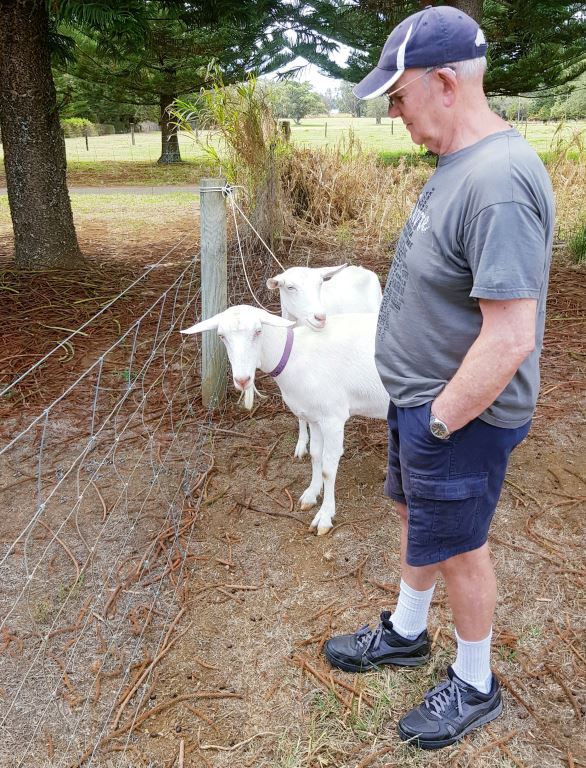
| Vol 69 | Page 17 |
Privacy Policy | Editorial Policy | Profit Policy | Join the Association | List of Members | Contact us | Index | Links
Back Go to page: 1 2 3 4 5 6 7 8 9 10 11 12 13 14 15 16 17 18 19 20 Forward
Contents:
Norfolk Island convict settlement.

Where are they now?
John David Ord.
Rob Wilson is trying to contact a previous serving friend, John Ord, a Radtech G. He was married to Wendy. Last known he was a lay preacher in Queensland. If anyone can help, let us know and we’ll pass on the details to Rob.
Dennis and Anne Wilkes.
Marion (aka Mandy) Beer is the eldest daughter of Jim and Gwen Beer. Her father served in the last couple of years of WW2 as a WO and then re-joined the RAAF in approximately 1952 as a permanent member of the RAAF, retiring at the age of 55, 3 years after the death of my mother. His mustering was Radio. His service No. is 051937 (I think). He spent time at Laverton, East Sale and Butterworth at active flying bases, also at Support Command in St Kilda Road, Melbourne and Ops Comm, Glenbrook NSW.
Marion would like to contact Dennis and Anne Wilkes, who were good friends of her parents. Unfortunately, following the death of her mother, she lost touch with a lot of her friends. She was googling and found Dennis' photo at a reunion a couple of years back.
If you can help Marion, let us know and we’ll pass on the info.
Paul Buldo.
Fiona Heairfield is trying to track down a long lost mate. He was on a course at Radschool mid 1987. Fiona doesn’t remember the course name, but was in the room next to the EDPOP basic course that I was on at the time. My question is, is there a list of courses available during 87 that I could suss out to see if he was listed. At the time he was CPL Paul Buldo. Thanks.
Fiona – at the moment we don’t have all the courses – but we’re working on getting them. If anyone can help Fiona, let us know and we’ll pass on the details to her. Tb
Brian Walmsley.
Dave Peters is looking for Brian Walmsley, they were both on 108 Telegs together. If you can help, let us know and we’ll pass on the info.

Sick Parade.
Ron Shannon.
The world’s second best Radtech, that very healthy Ted Mac from the West, said he recently had a yarn with Ron Shannon, an ex 15 Radio Appy, the first Appy course to start at Laverton (1961).
Back in February, Ron was savagely attacked in his own yard. A 29 year old man attached Ron, knocked him to the ground and stomped on his head after he had been caught trying to steal a broken scooter from Ron’s backyard. Luckily a neighbour came to his aid but not before the attacker also stole Ron’s car.
Ron was taken to the Royal Perth Hospital but allowed to go home the following afternoon. Ted says Ron’s physical condition is now improving (albeit he cannot do what he could a few years ago) but his mind/memory is suffering.

Stuff.
At the end of February, the Diploma Cadet Squadron’s Number 11 Engineering Course, (No1 Commerce), celebrated their 55th anniversary on Norfolk Island. Thirty five blokes and their lovely ladies made the journey. They were all together at RMIT for four years in the late 60s and have been having reunions every 2½ years since 1990.
Laurie Lindsay made the trip, and for reasons unknown, was allowed by the authorities to return to Oz, and while over there he said he took some pics which he wrapped in brown paper and posted to us.
He says, “Norfolk Island is a great place. You can leave your car open and also your house/apartment. The speed limit is 50 km/hour and it is strongly enforced by the number of potholes in the roads. You must always give way to cattle which graze by the side of the roads and the place is infested with feral chooks. The Norfolk Islanders are terrific people and very friendly. It reminded me of Australia in the 1950s and that is not a derogatory remark. Anybody who wants a great holiday is urged to contact the Norfolk Island Travel Centre HERE.” - for which he was well paid.
We later found out that Floyd Wilson actually took the photos, we know from past experiences anything with a battery in it is a bit beyond Laurie’s comprehension.
The following pic is of all the lovely ladies who went along to keep their old blokes on the straight and narrow.
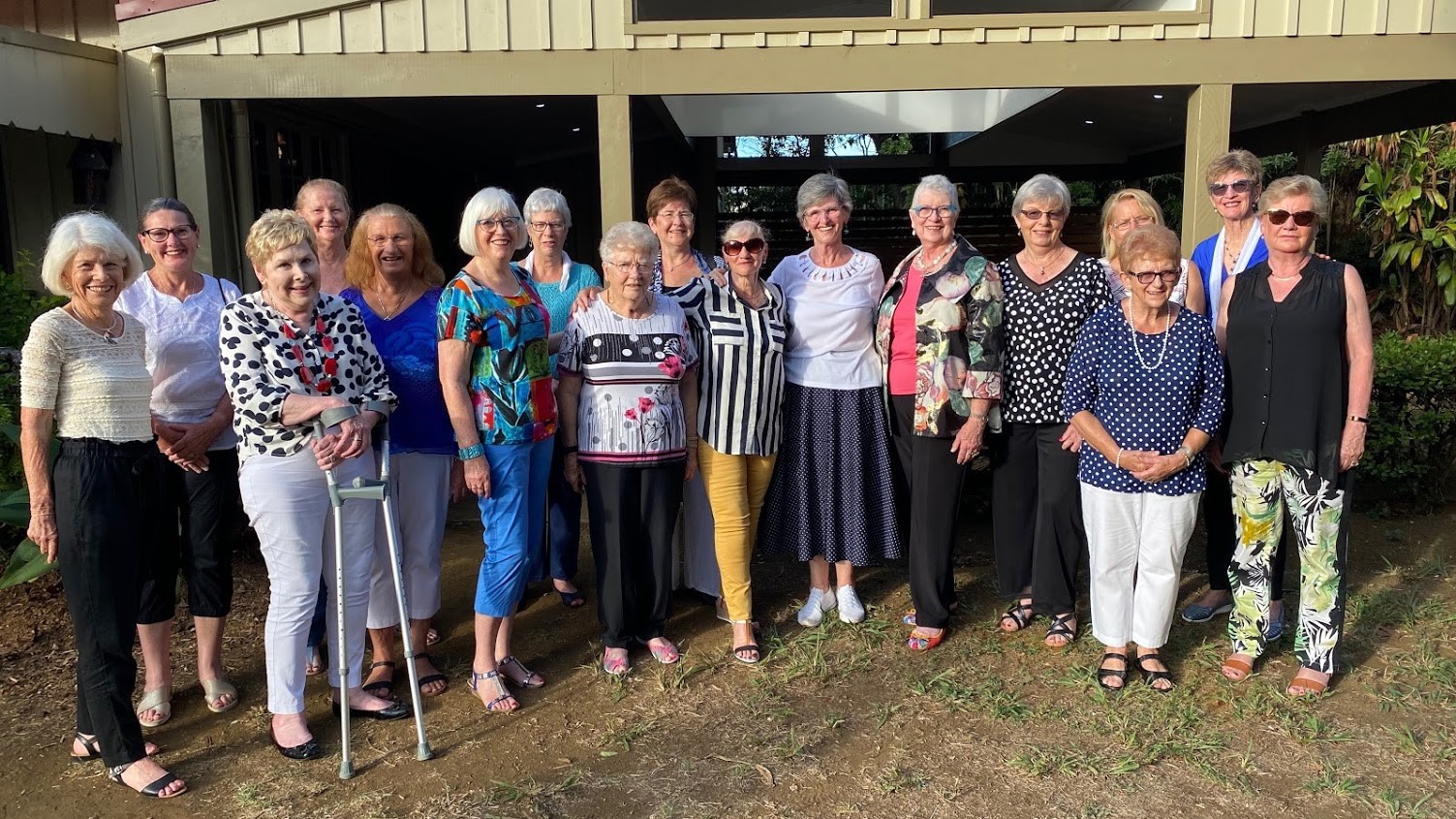
L-R: Bev Sillett, Elva Edwards, Chris Hogendijk, Dee Knott, Julie Western, Carol Jewell, Chris Grohovaz, Wilma Nelowkin, Vicky Kennedy, Anita Giles, Sandra Robey, Viv Chandler, Majella Wilson, Wendy Prowse(behind), Cheryl Riley, Helen Bukmanis, Janine Neil.
And the blokes were:
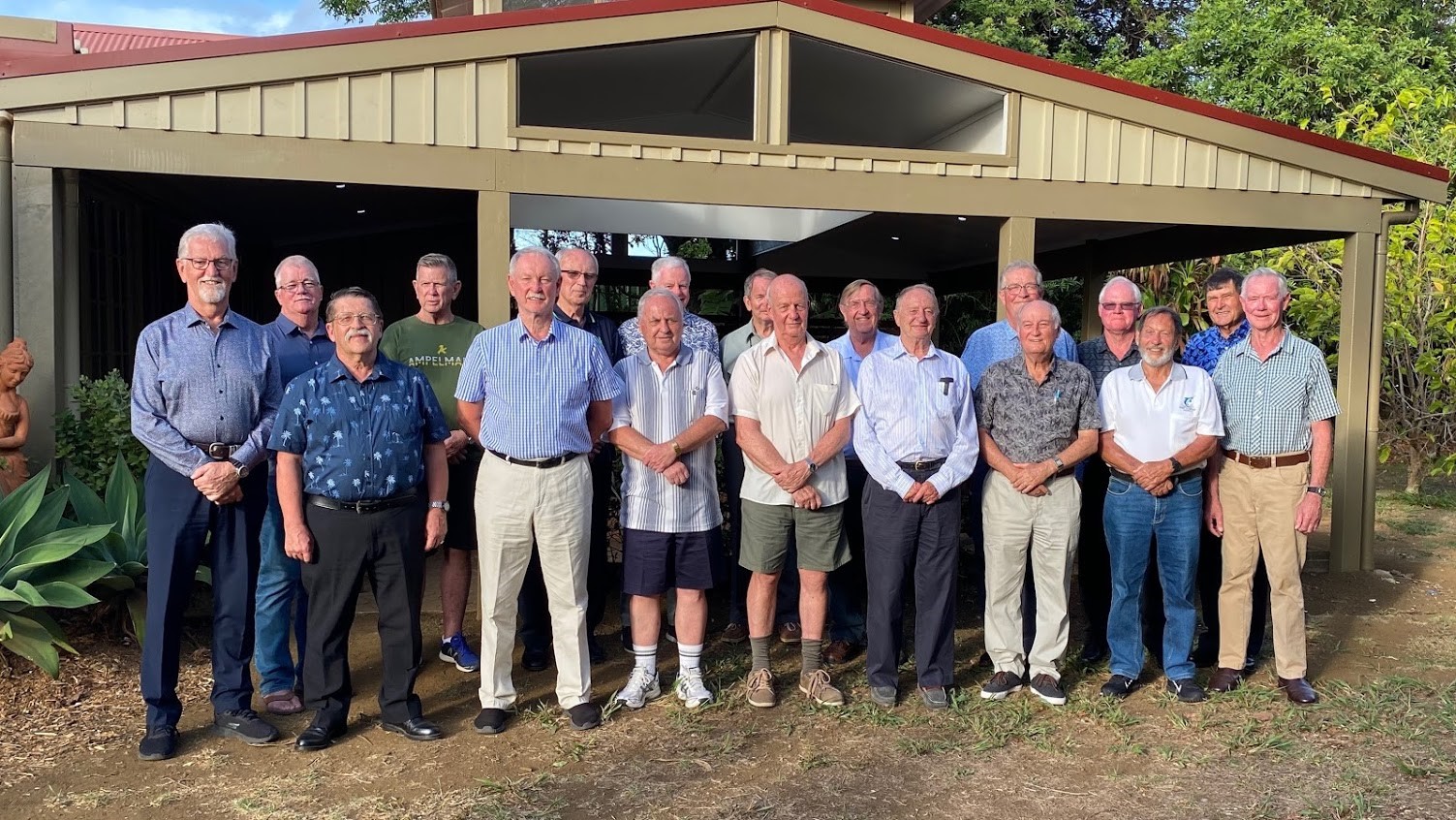
L-R: Floyd Wilson, Mal Knott, Wally Nelowkin, David Edwards, Jim Kennedy, Andy Hogendijk, Gary Riley, Paul Robey (behind), Bruce Chandler (behind), Laurie Lindsay, Ken Western, Elio Grohovaz, Col Giles (behind), Barry Sillett, Chris Neil, Dave Prowse, Val Bukmanis, Dick Allanson
Some other pics.
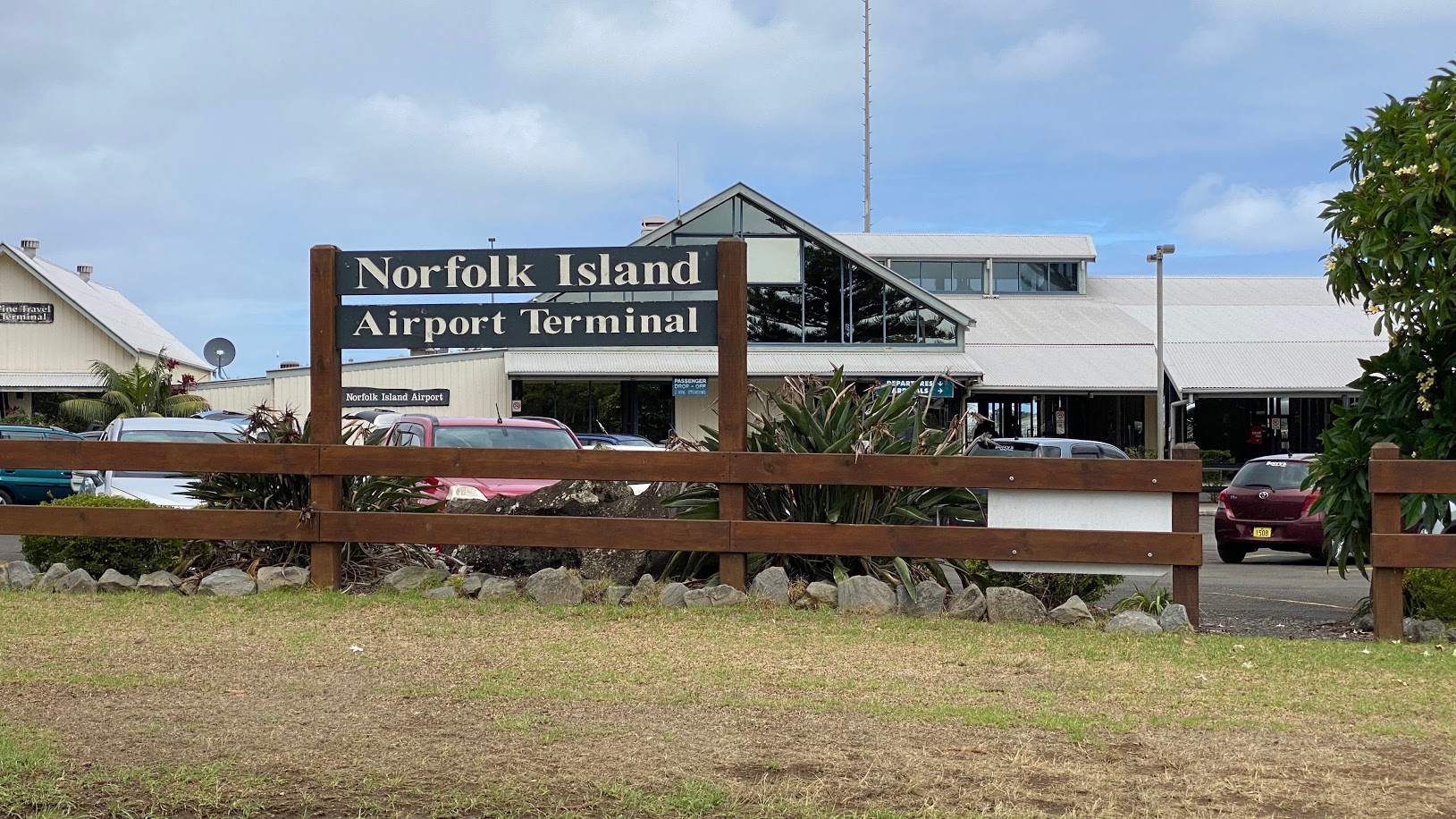
During WW2, the US Army Air Force requested that the Australian government construct an aerodrome on Norfolk Island for use by its heavy bombers. The first runway was completed in late 1942, with a RNZAF aircraft landing on Christmas Day. The second runway was opened in February 1943.
The construction of the runways necessitated the destruction of Pine Avenue, a local landmark consisting of about 500 Norfolk Island pines reaching up to 50 metres in height. As Norfolk Island did not have enough flat ground, in 1942 several bulldozers were used to knock the tops off several hills and fill in the valleys between them. Steel mesh was then used to make a solid surface.
The airfield was never used as an operational base, but was available to the Allies for use as a staging depot, a refuge for aircraft in distress, and a possible base for anti-submarine patrols. An RNZAF Radar Unit operated on the island as a navigational aid and it became a stopover for aircraft travelling between Australia, New Caledonia, New Zealand and the Solomon Islands. The RNZAF left the airfield in July 1946.
These days Norfolk Island is an important transit and refuelling point for light aircraft flying between Australia, New Zealand, and the Pacific Islands. The main runway is 6,400 feet long and can handle aircraft up the Boeing 737 and/or the Airbus A320.
Movements at the airport are very light with an average of between 2-3 aircraft a day.
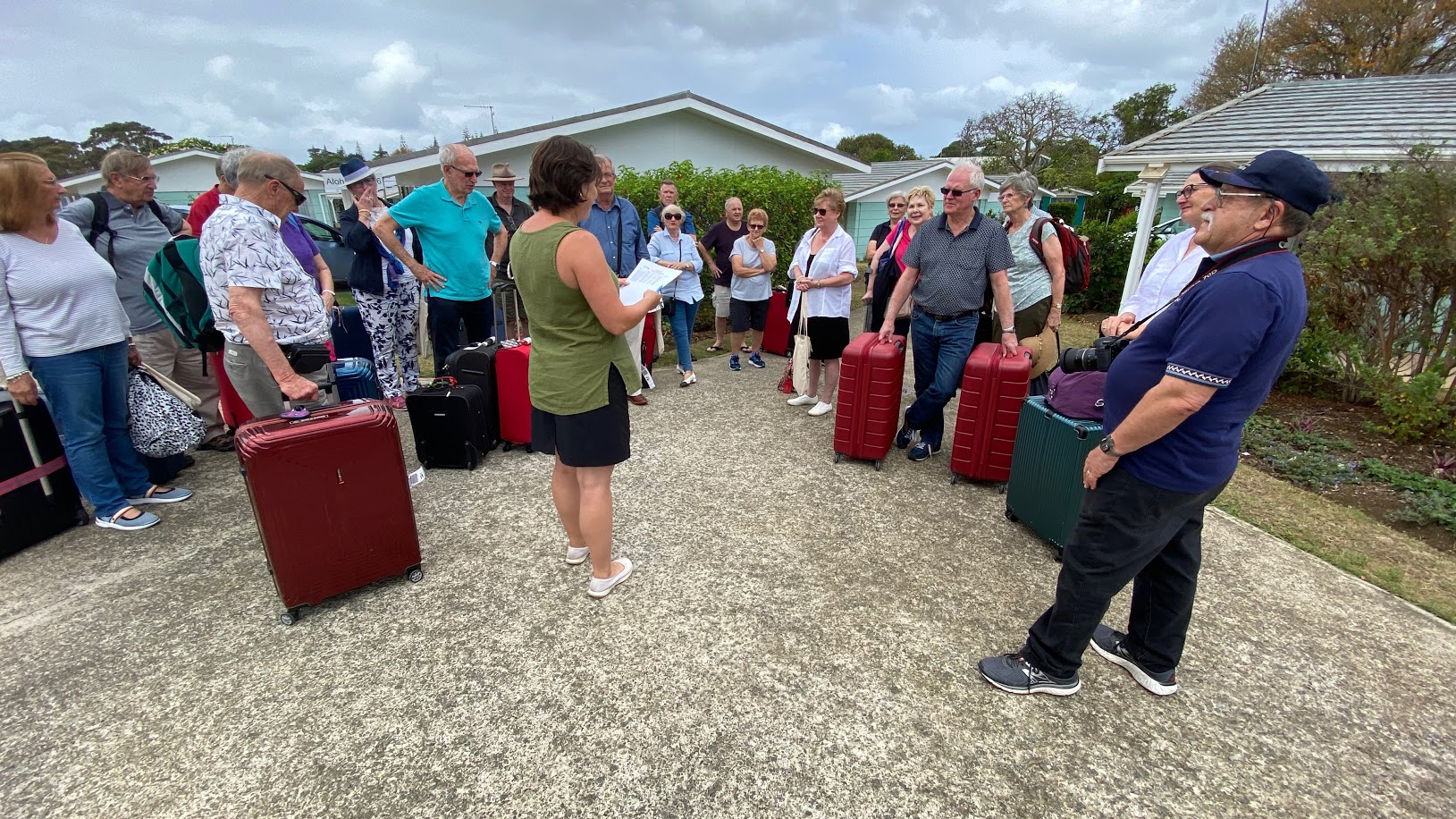
The troops and the troopettes were met at the airport and bussed to the Aloha Apartments and told by the boss lady to form up so they could be detailed off and allocated their dongas. As you can see, discipline was a bit lax.
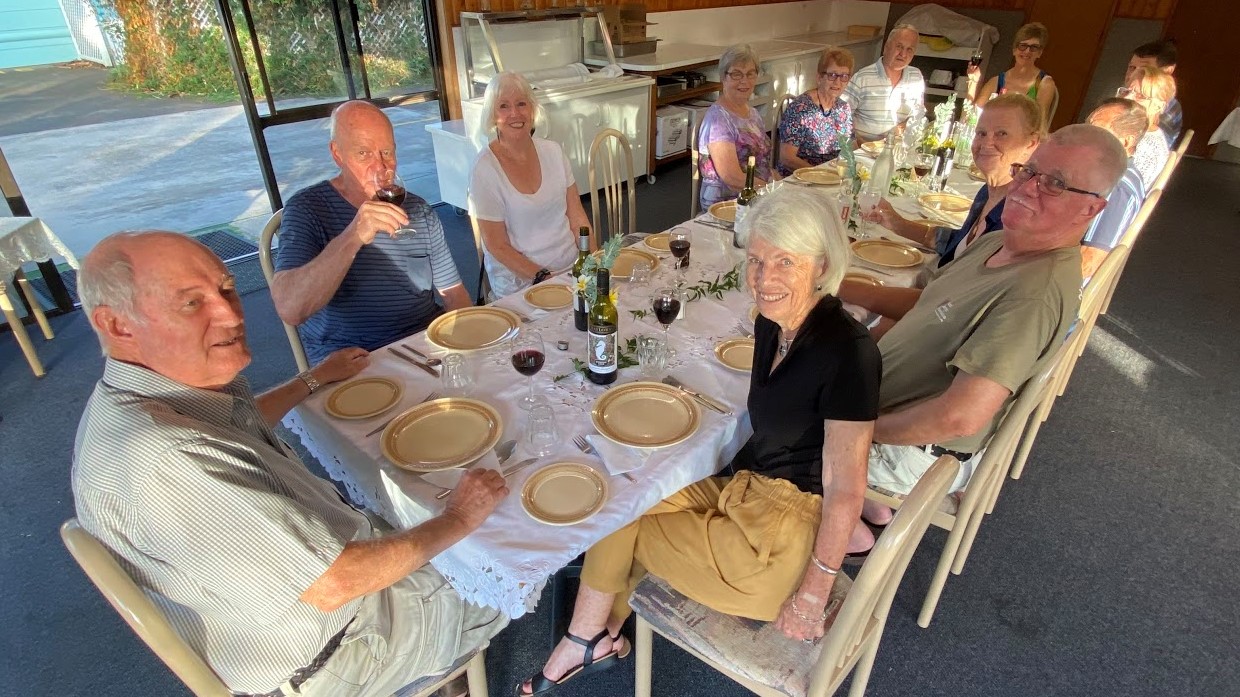
Because of the airline schedules, the Queenslanders arrived a day earlier than the Mexicans and the Aloha Apartments provided them with a bar-b-q lunch.
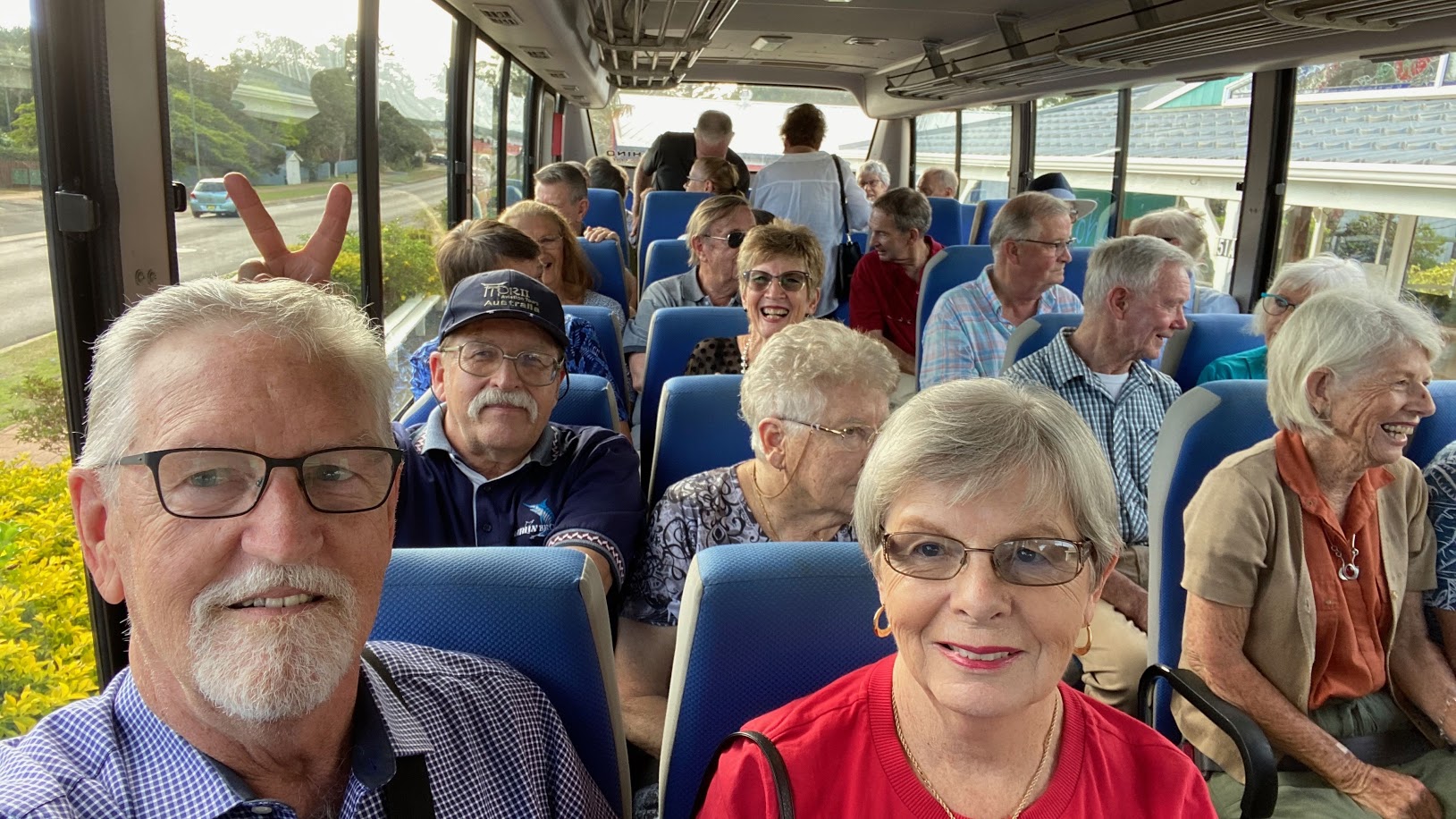
After everyone was settled in, it was onto the bus for an island orientation tour. Floyd and Majella Wilson in the front row and behind them Wally and Wilma Nelowkin.
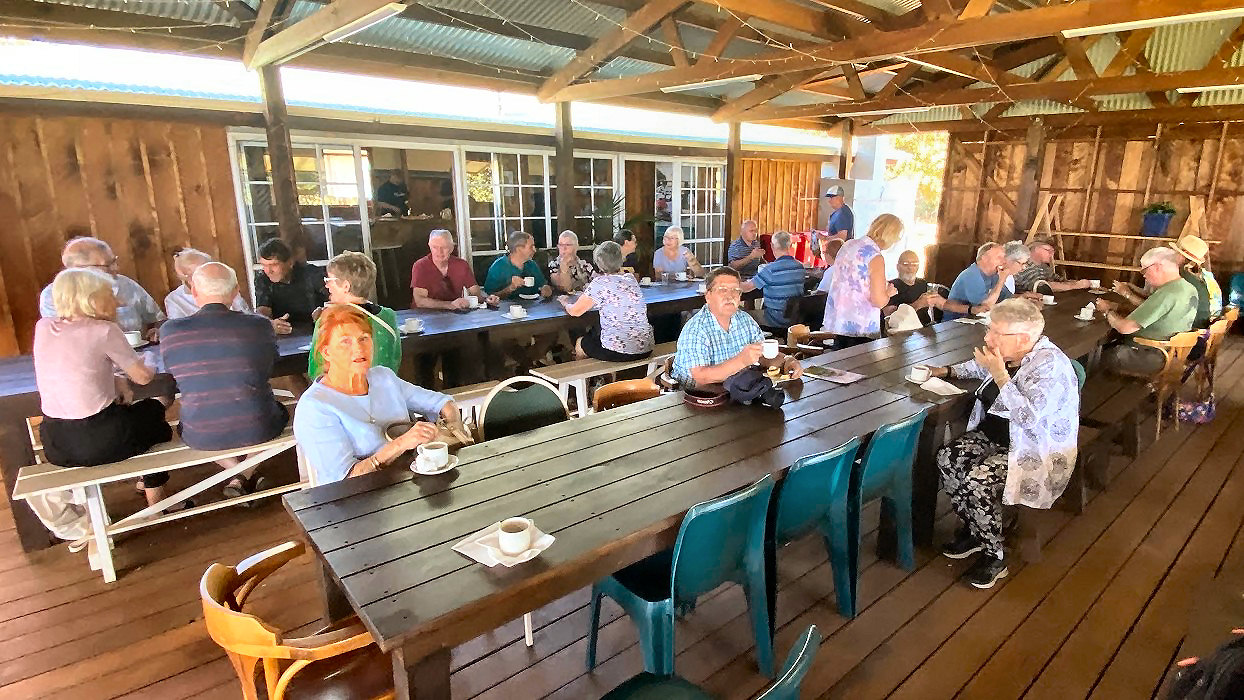
After their strenuous and very taxing 30 minute orientation drive around the island, it was high time to pull up for a breather and a cuppa and to rest the weary old bones.
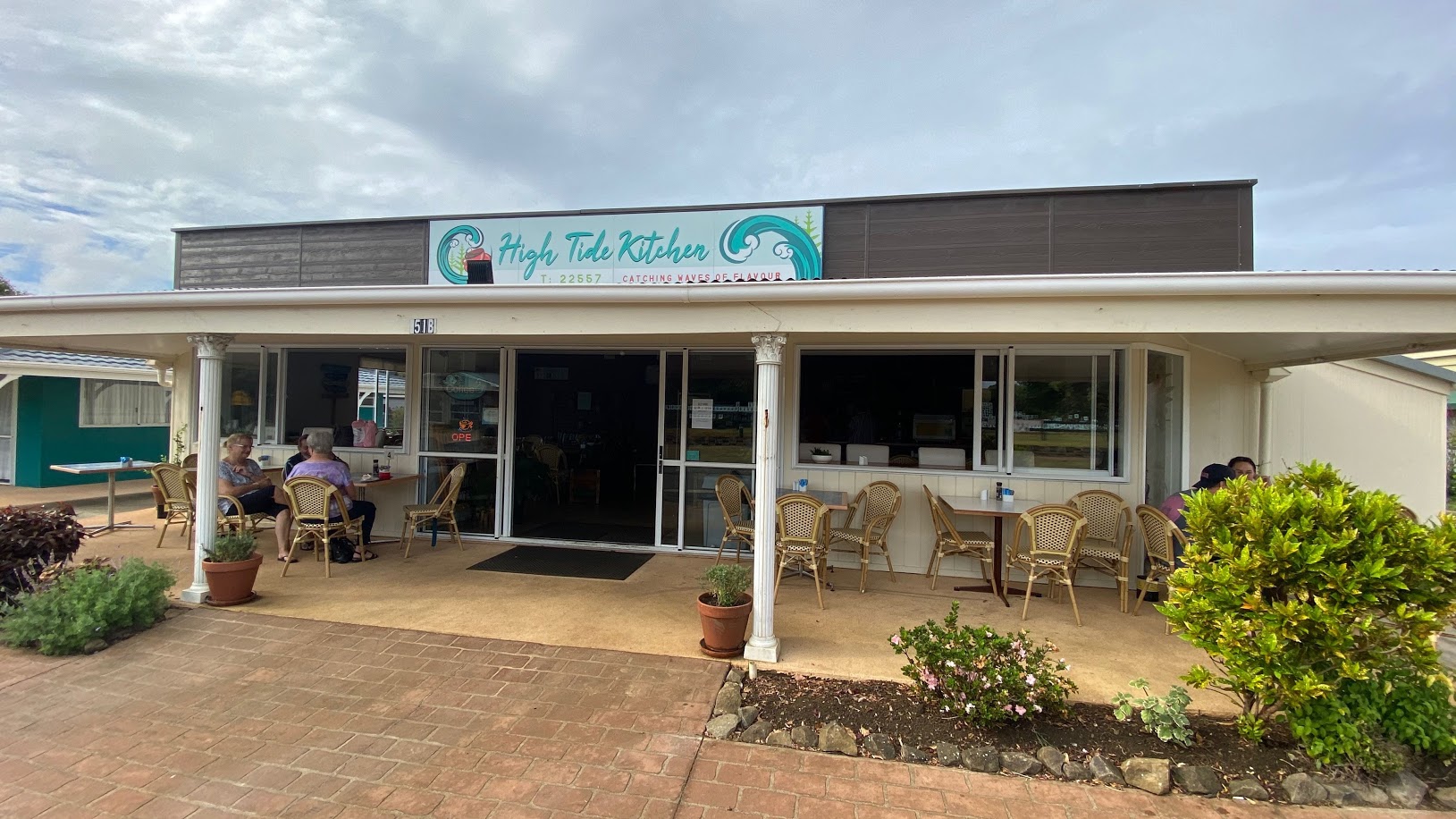
The high tide kitchen was next to their Aloha Apartments and was just the spot for breakfast and morning smoko.
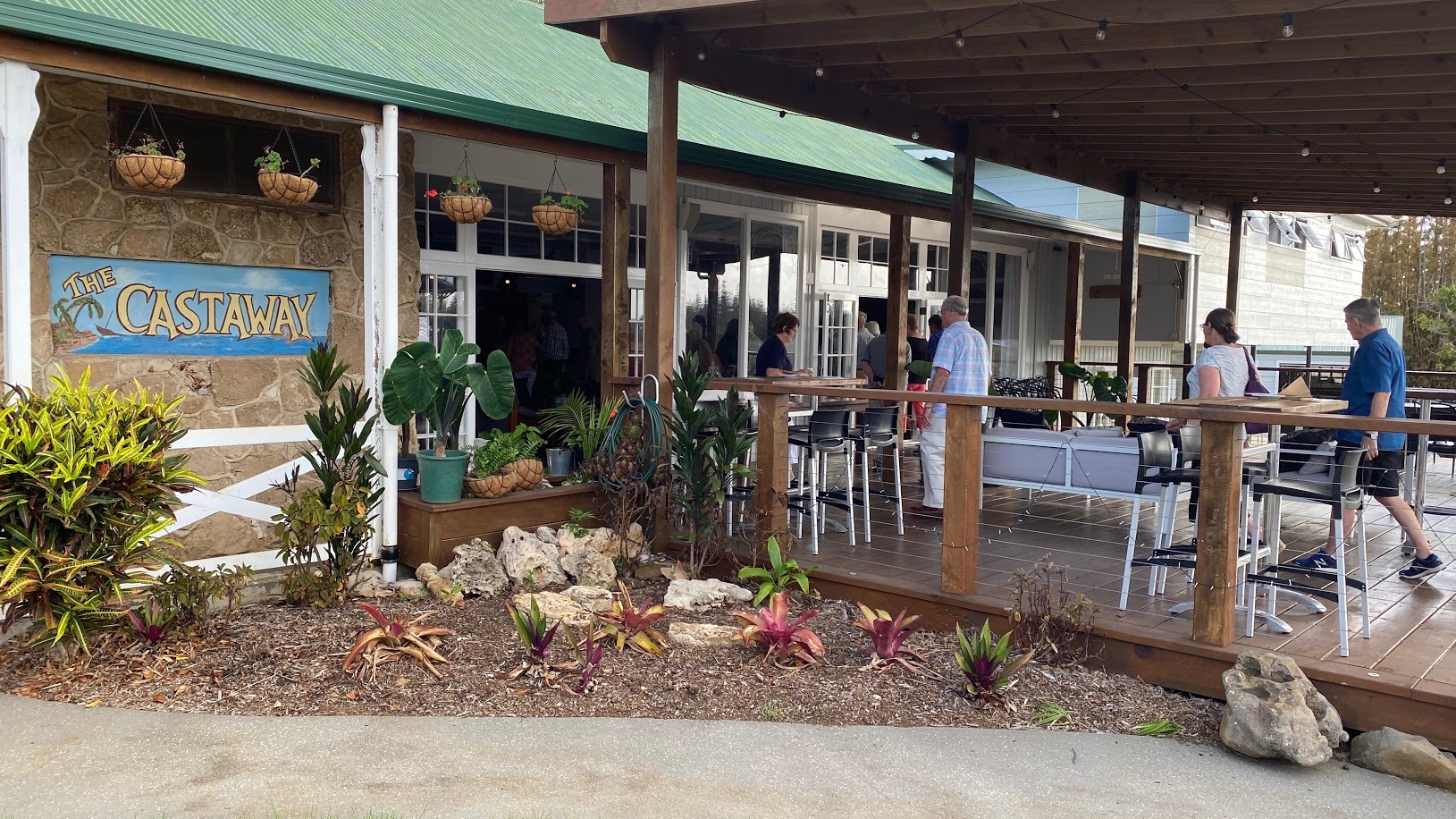
While just up the road was the Castaway Hotel, where they had Sunday Dinner.
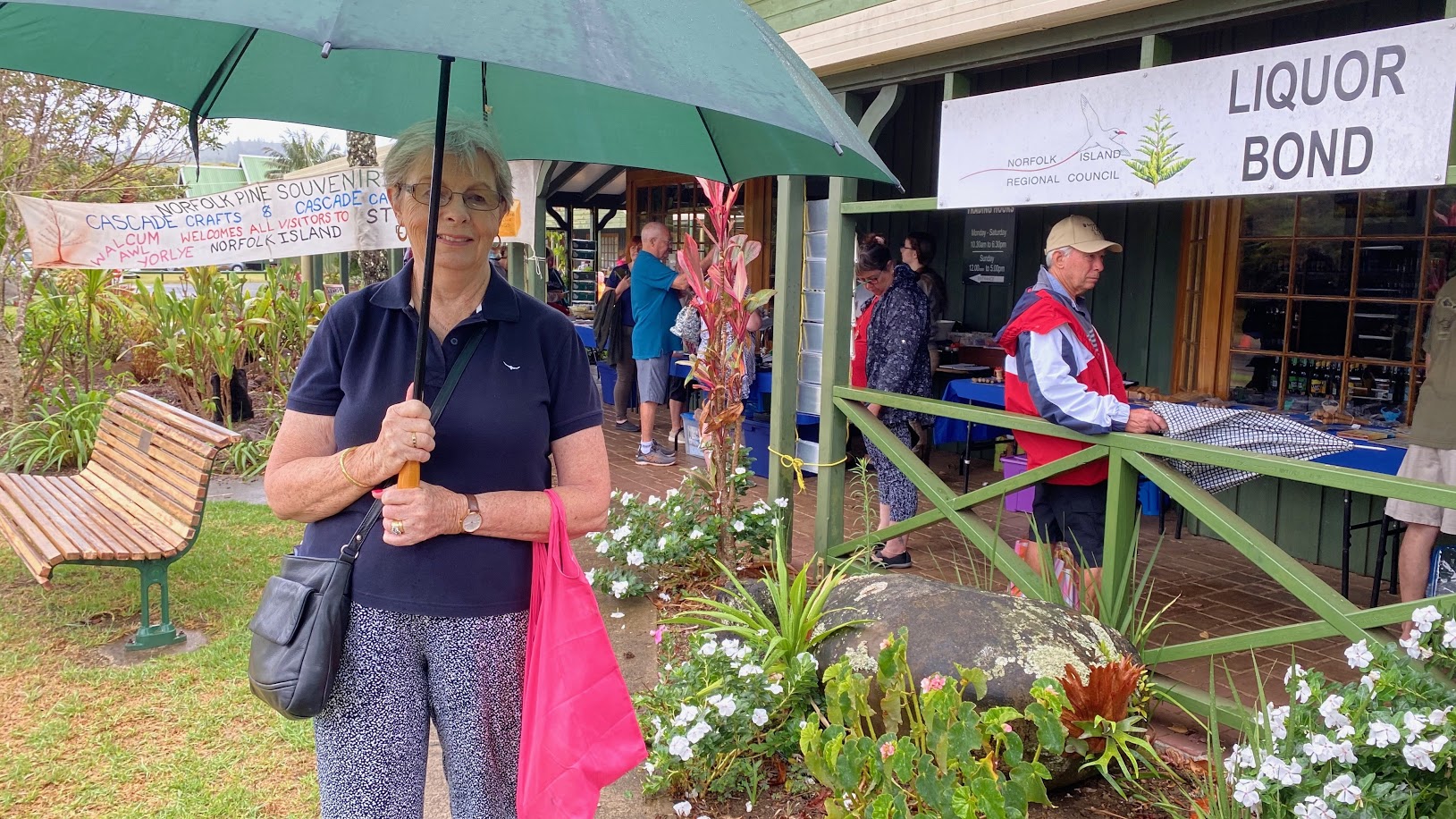
And what would an Ex-RAAFies do be without a bunch of coldies, Majella Wilson drew the short straw and headed for the bottleO for supplies and nicked an umbrella while no-one was looking.
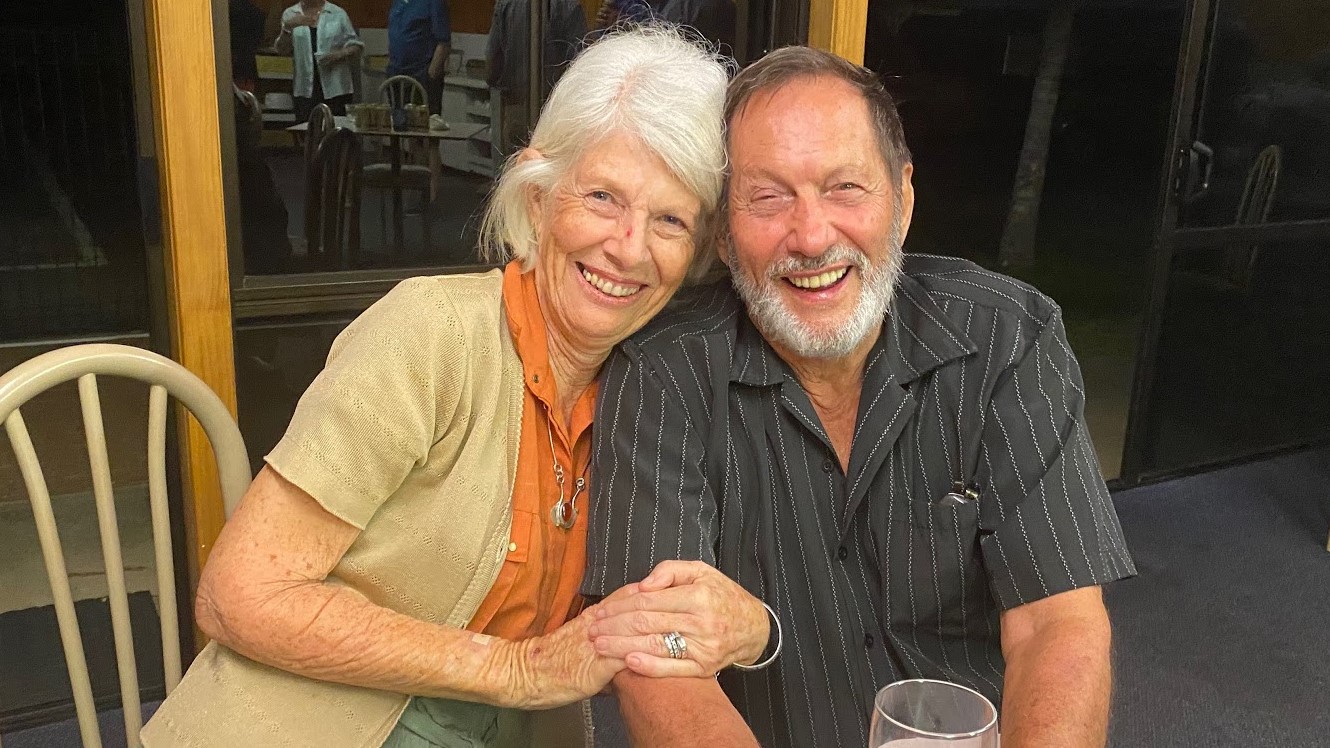
Bev Sillett and Dave Prowse.
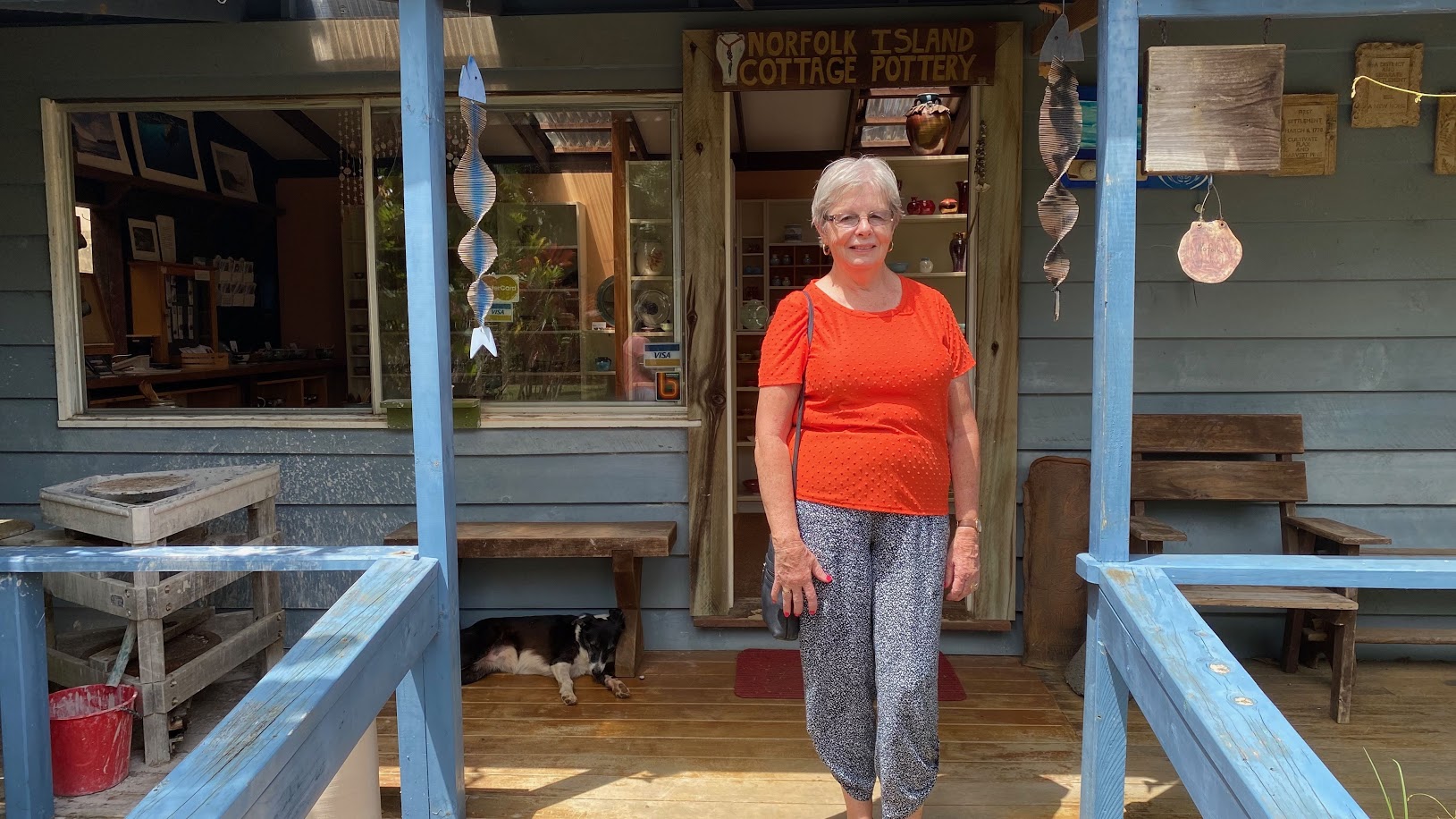
Majella Wilson stocking up on stubby holders, ash trays and glass paper weights from the souvenir shop.
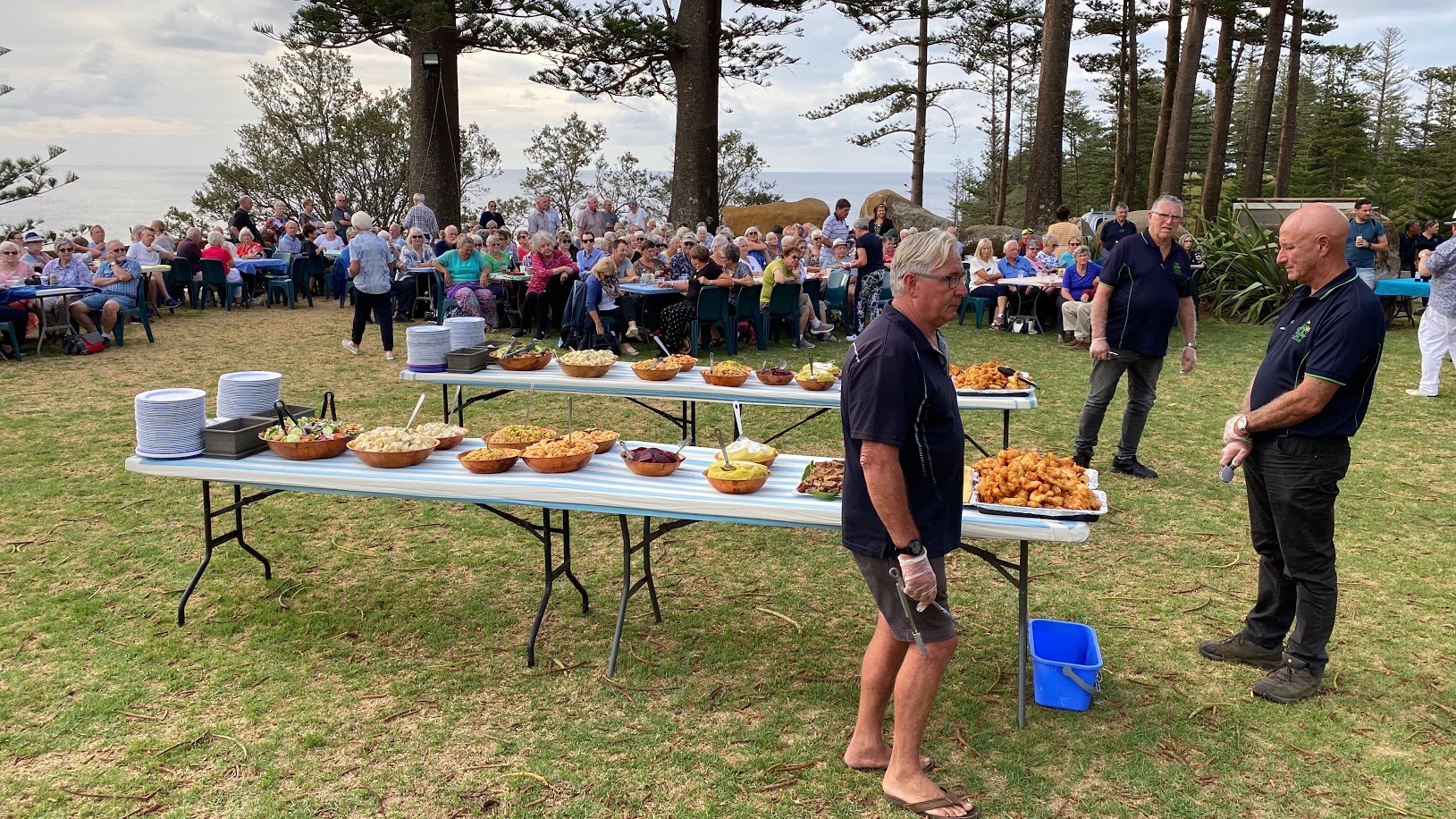
Tuesday night was the Island Fish Fry which is one of the favourite
Norfolk Island experiences held at Puppy's Point overlooking gorgeous
coastal scenery. Guests are treated to a glorious feast of fresh fried
fish, salads, homemade bread, sweets, tea and coffee. Local entertainers
a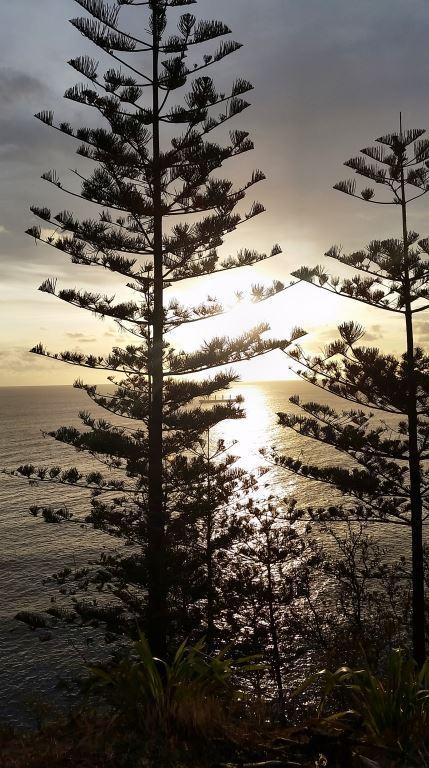 dd
to the ambience as travellers are encouraged to join in the sing-a-long
and festivities.
dd
to the ambience as travellers are encouraged to join in the sing-a-long
and festivities.
They say watching the sunset is one of the most relaxing activities we know. As the sun lowers itself beyond the horizon, the sky paints a palette of almost unimaginable beauty, a glorious sight of pinks, oranges, reds, deep purples and rich blues.
Norfolk is arguably one of the most picturesque locations on earth to watch this magical event. There are only three things that could make it any better, good company, great food and live music. Thankfully, you find this on Norfolk with the Island Fish Fry.
You are taken out to the cliff top and the Fish Fry starts at 5pm, ensuring you don’t miss the sunset even in winter. You enjoy a feast of Island dishes, salads, homemade bread and fresh fried fish, followed by Island desserts, then tea or coffee.
The Island Fish Fry is fun for the whole family, blending the perfect mix of some of the best food on Norfolk, fun entertainment and a spectacular view. And after the sun sets, you’ll still have time to be entertained for the rest of your evening.
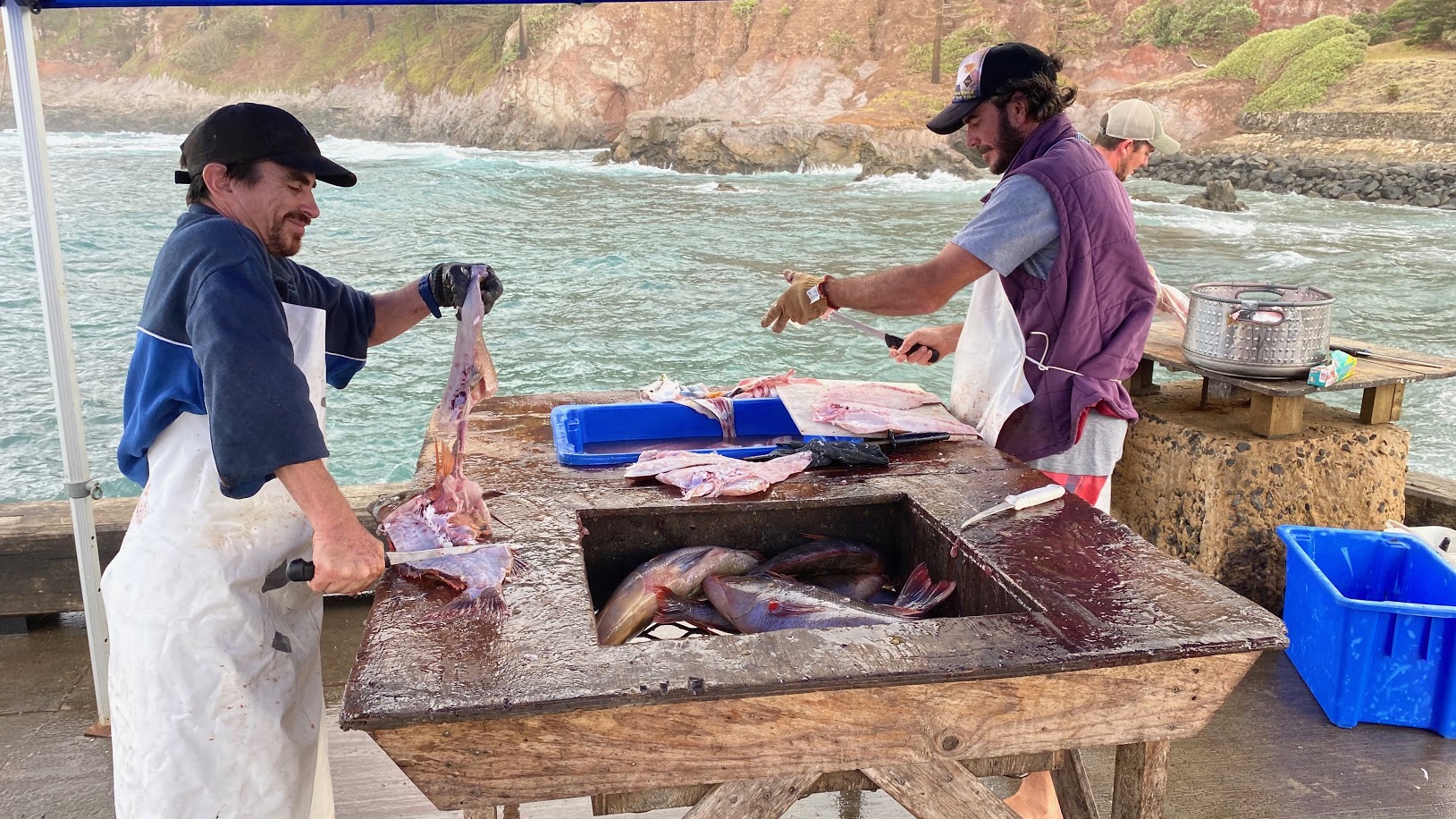
Before the fish (Trumpeter) could be cooked it had to be cleaned, these two blokes were expert.
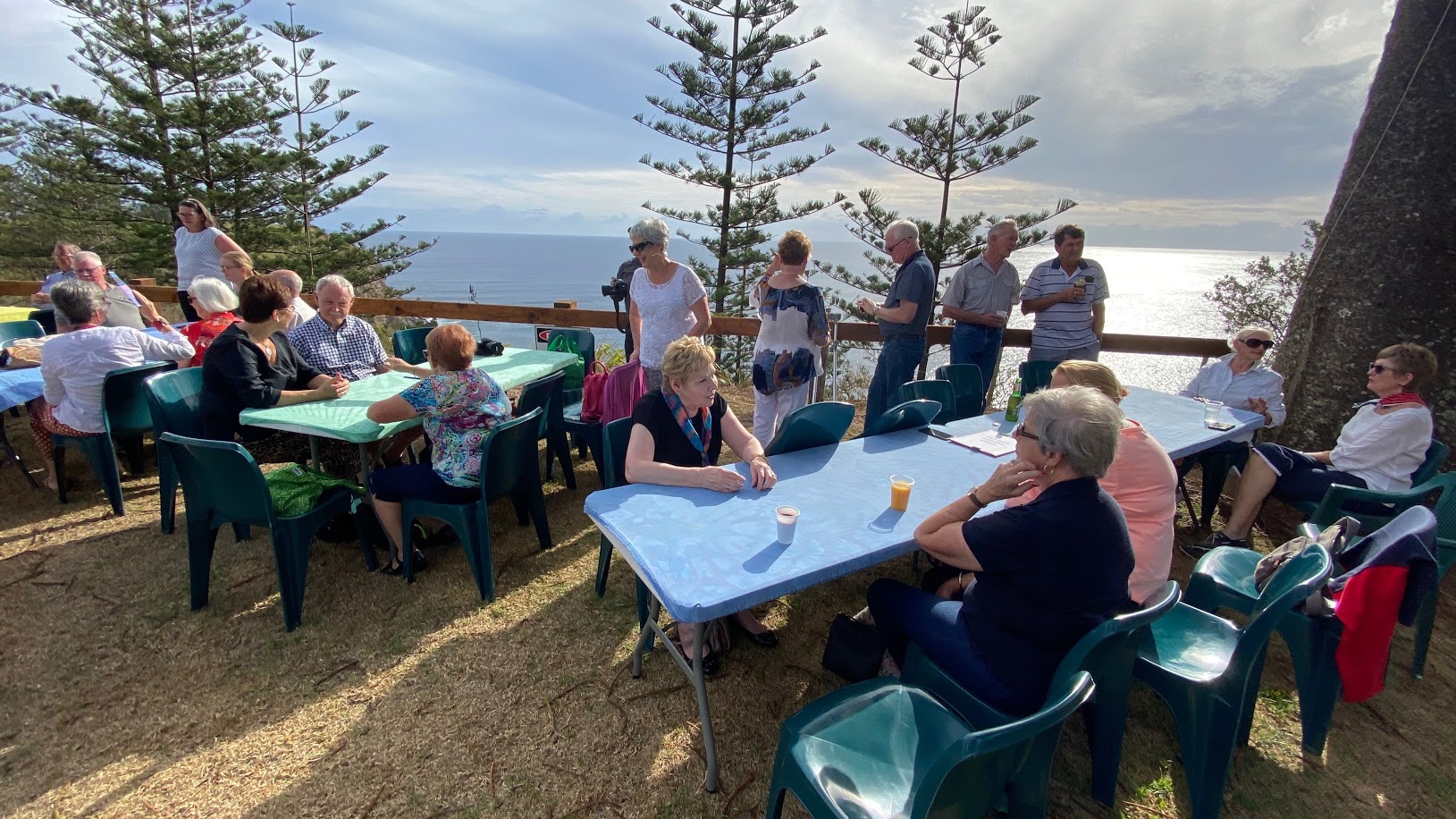
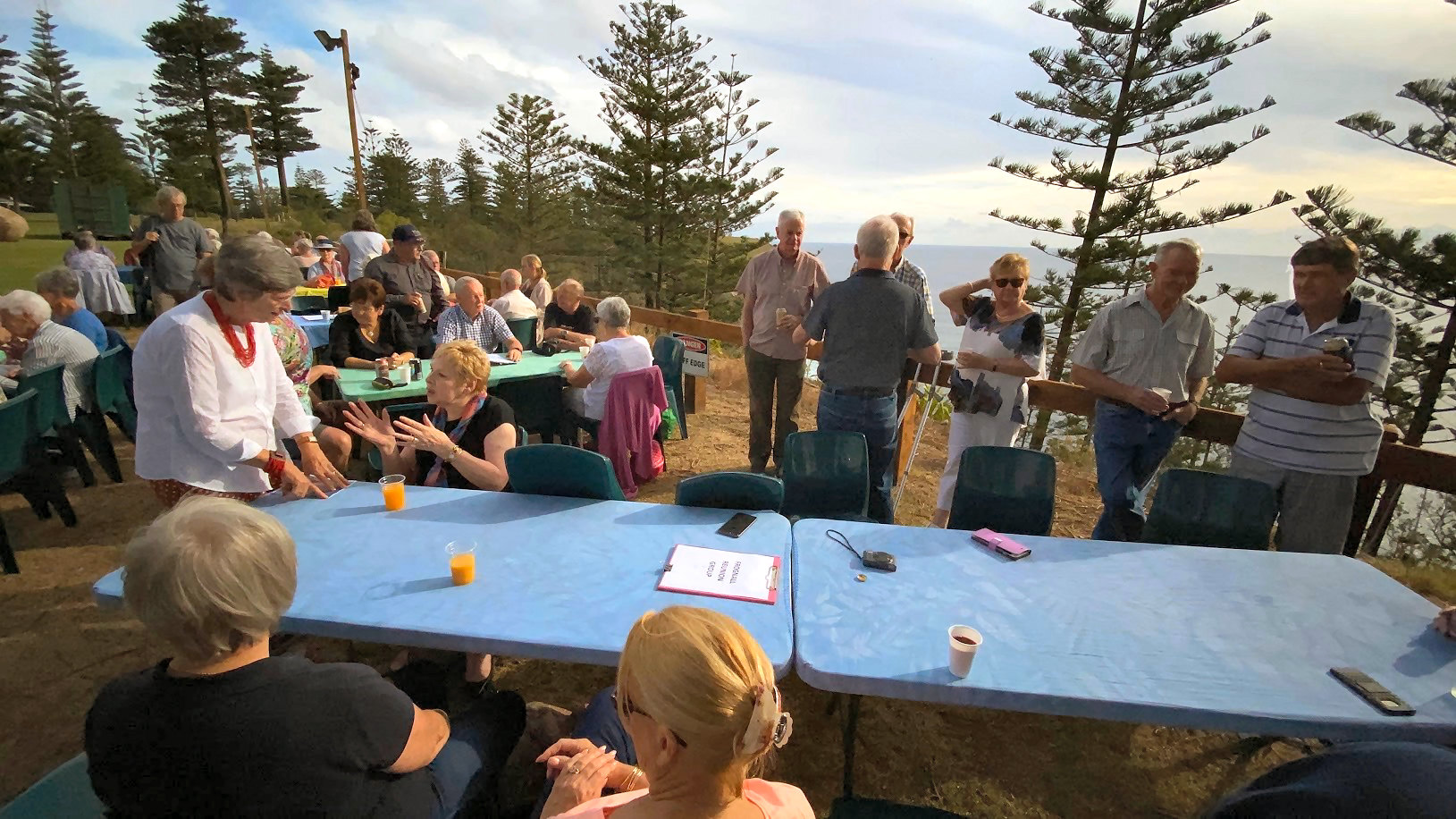
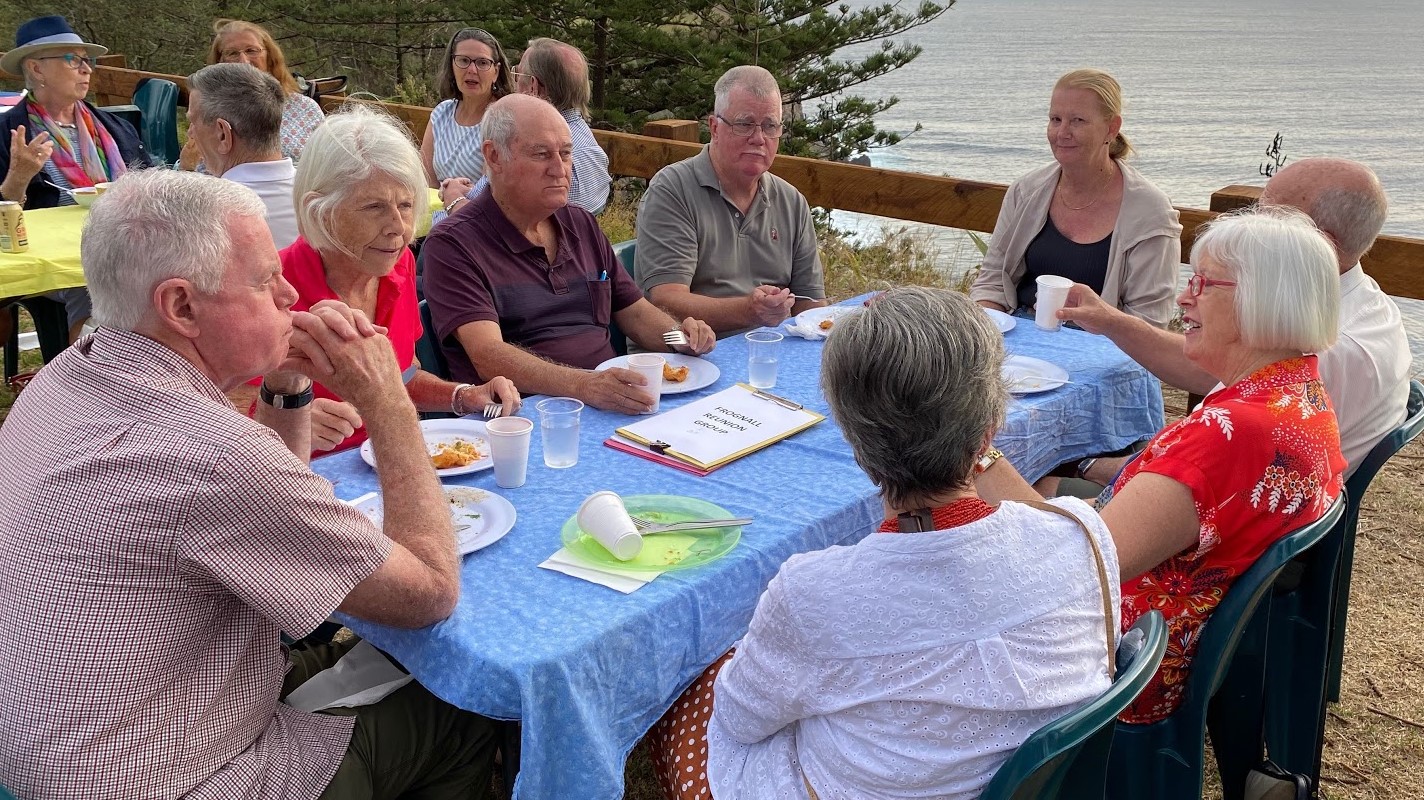
Clockwise around the table from 9.00o’clock: Paul Robey, Bev Sillett, Barry Sillett, Mal Knott, Dee Knott, Laurie Lindsay, Carol Jewell, Sandra Robey.
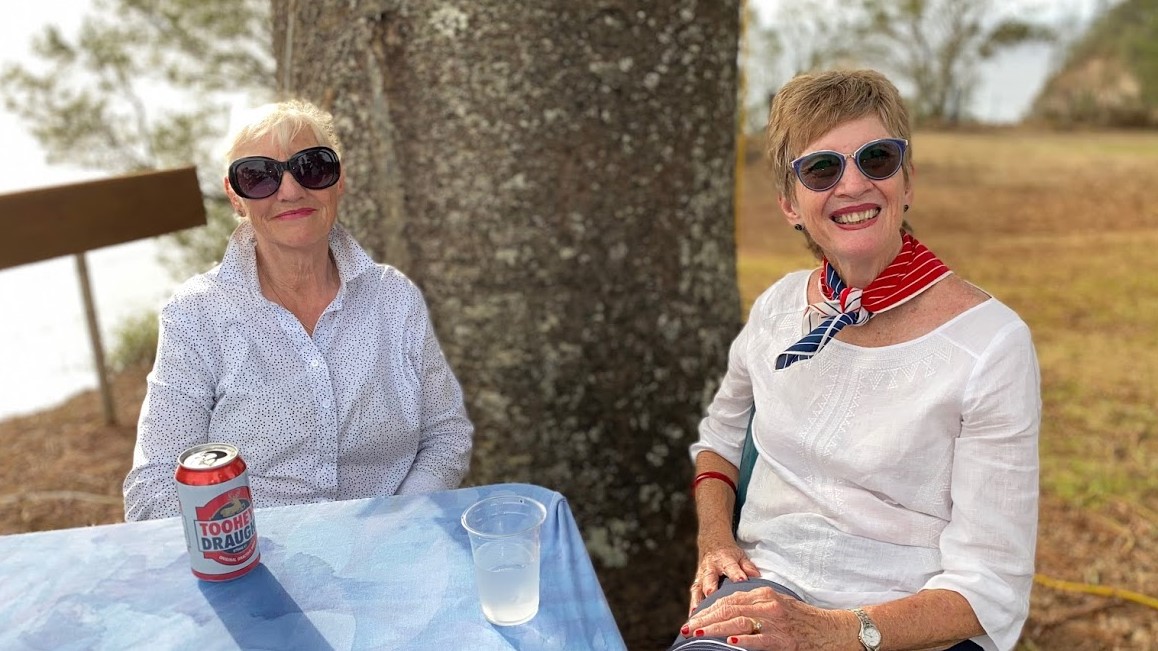
Anita Giles and Helen Bukmanis.
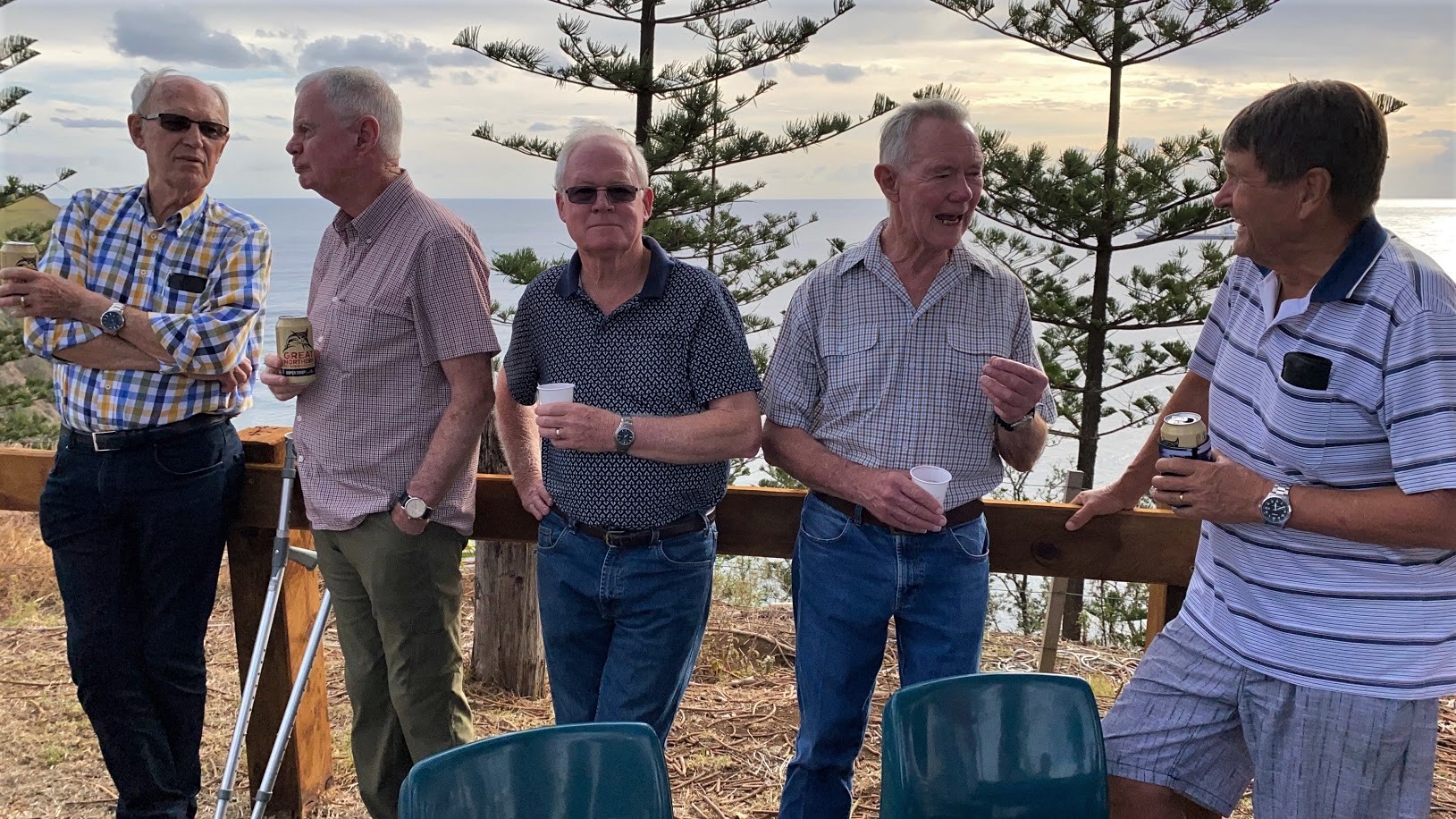
Andy Hogendijk, Paul Robey, Chris Neil, Dick Allanson, Val Bukmanis.
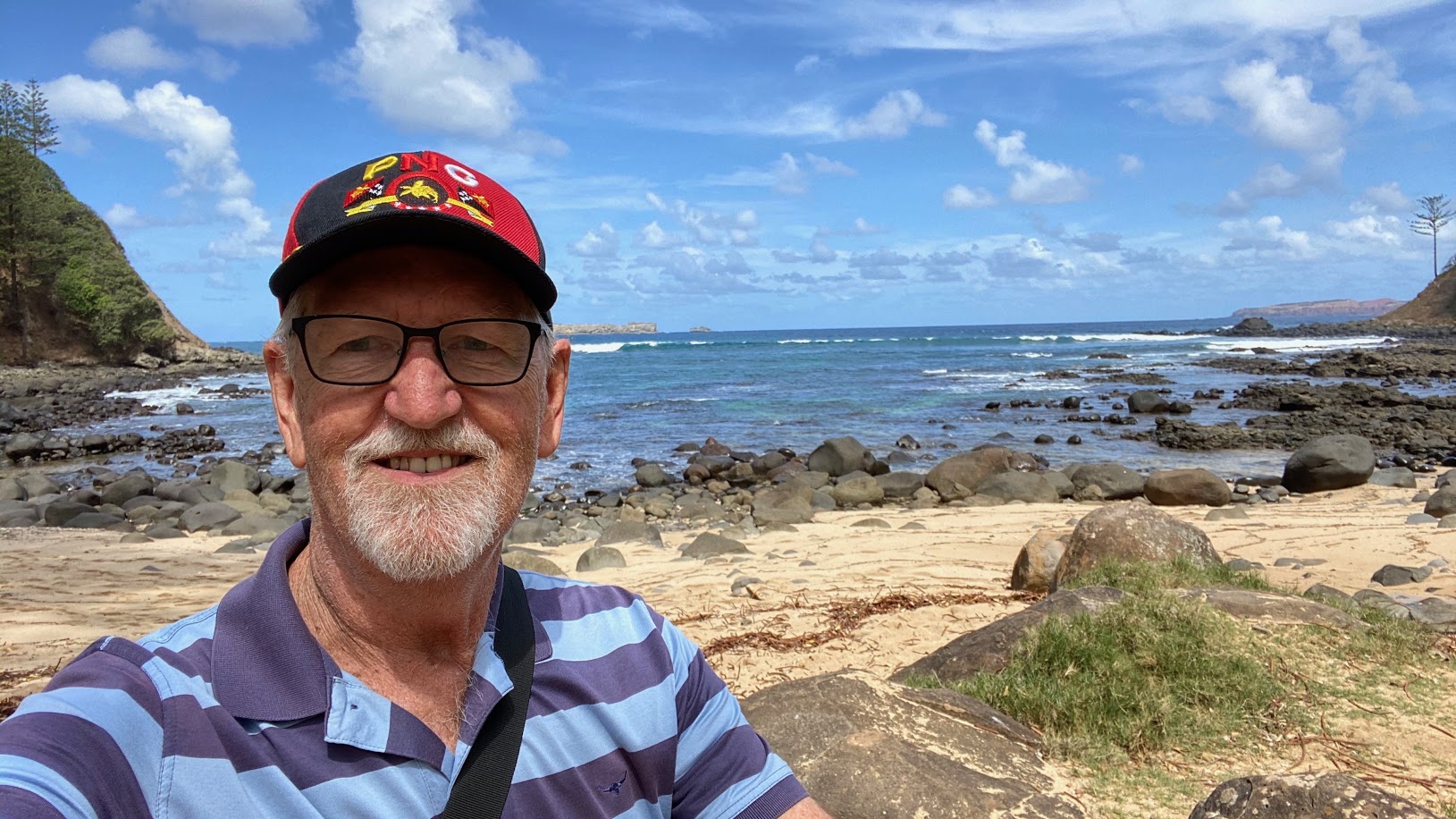
Floyd Wilson.
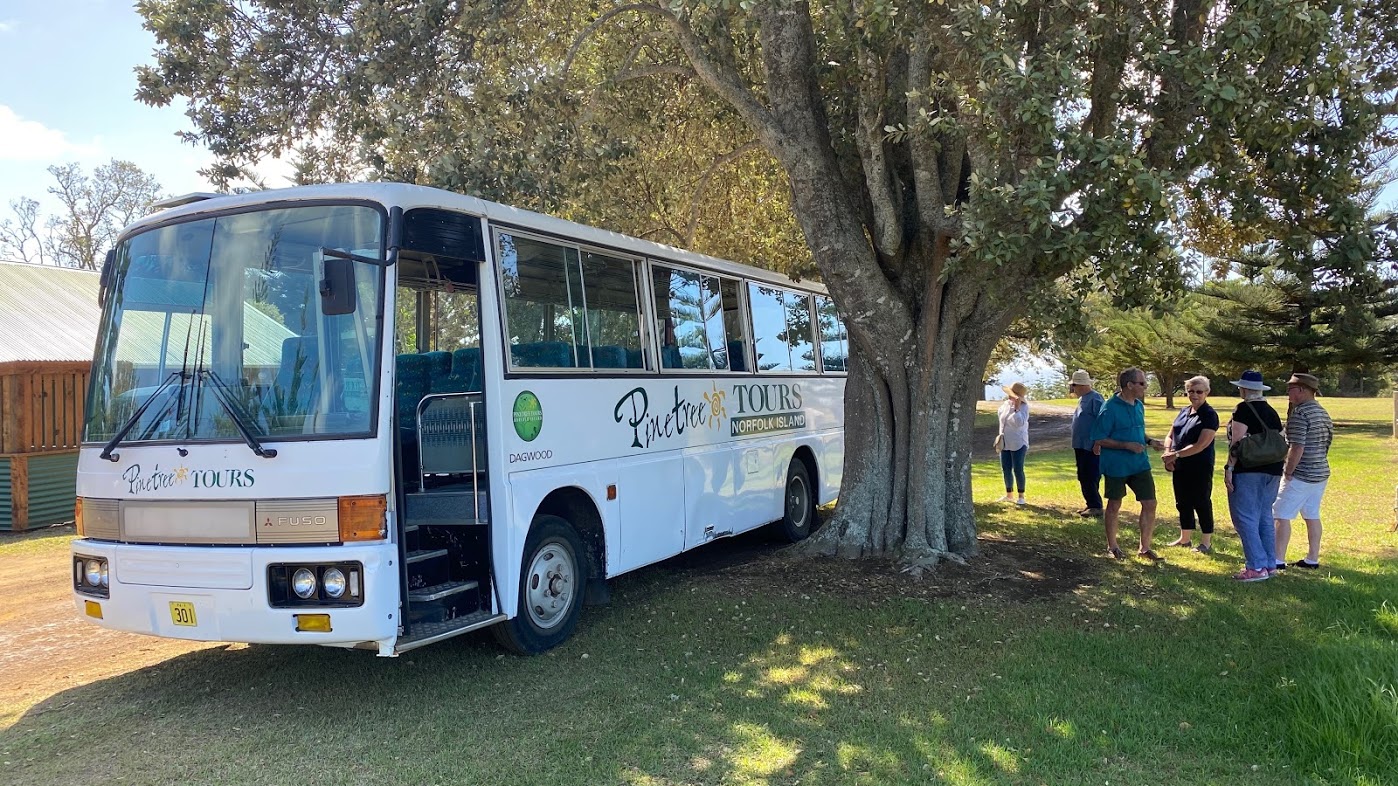
Transport on the Island was provided by Pine Tree tours.
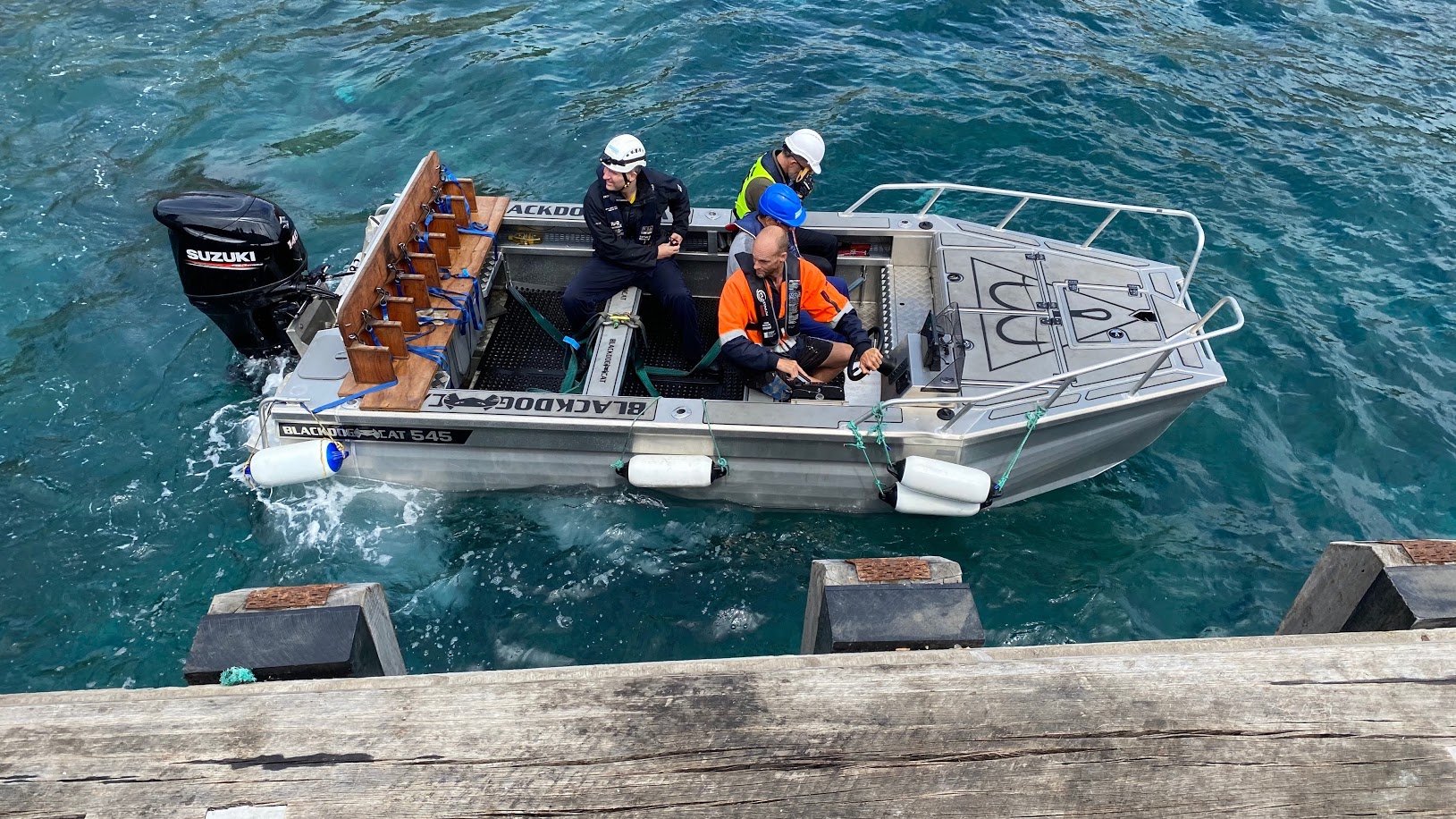
This boat carried inspectors out to a couple of ships that were off-loading rocks used by contractors working on re-surfacing the airport runway.
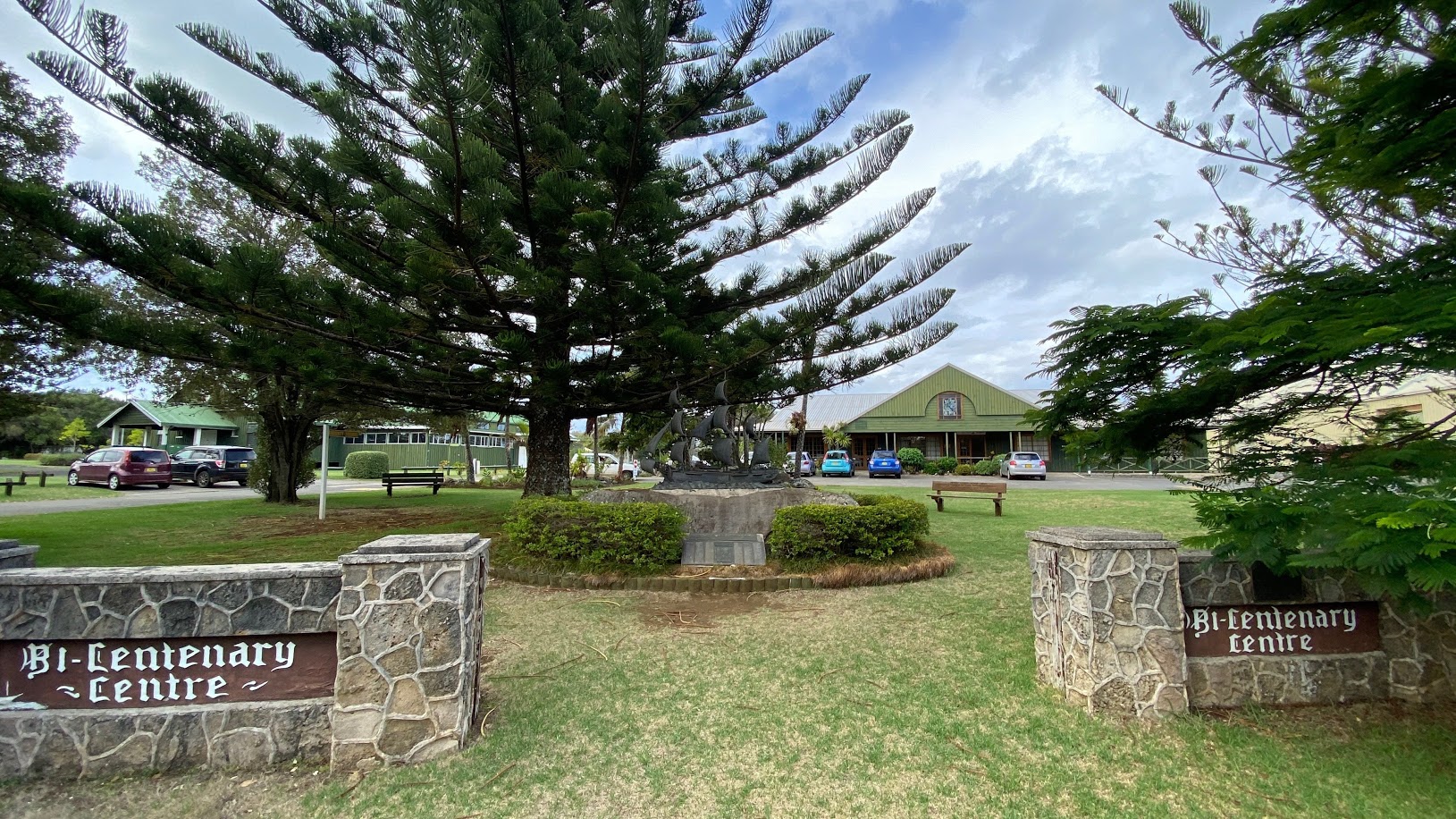
The entrance to the Bi-Centenary Centre where there is a monument commemorating the arrival of the Pitcairn Islanders (descendants of the Bounty mutineers) on Norfolk Island in 1856. . This Centre was opened in October 1974 to also commemorate the discovery of Norfolk Island by Captain James Cook in 1774. It contains the Island’s Visitor Information Centre, the Post Office and the Customs House and Immigration Centre.
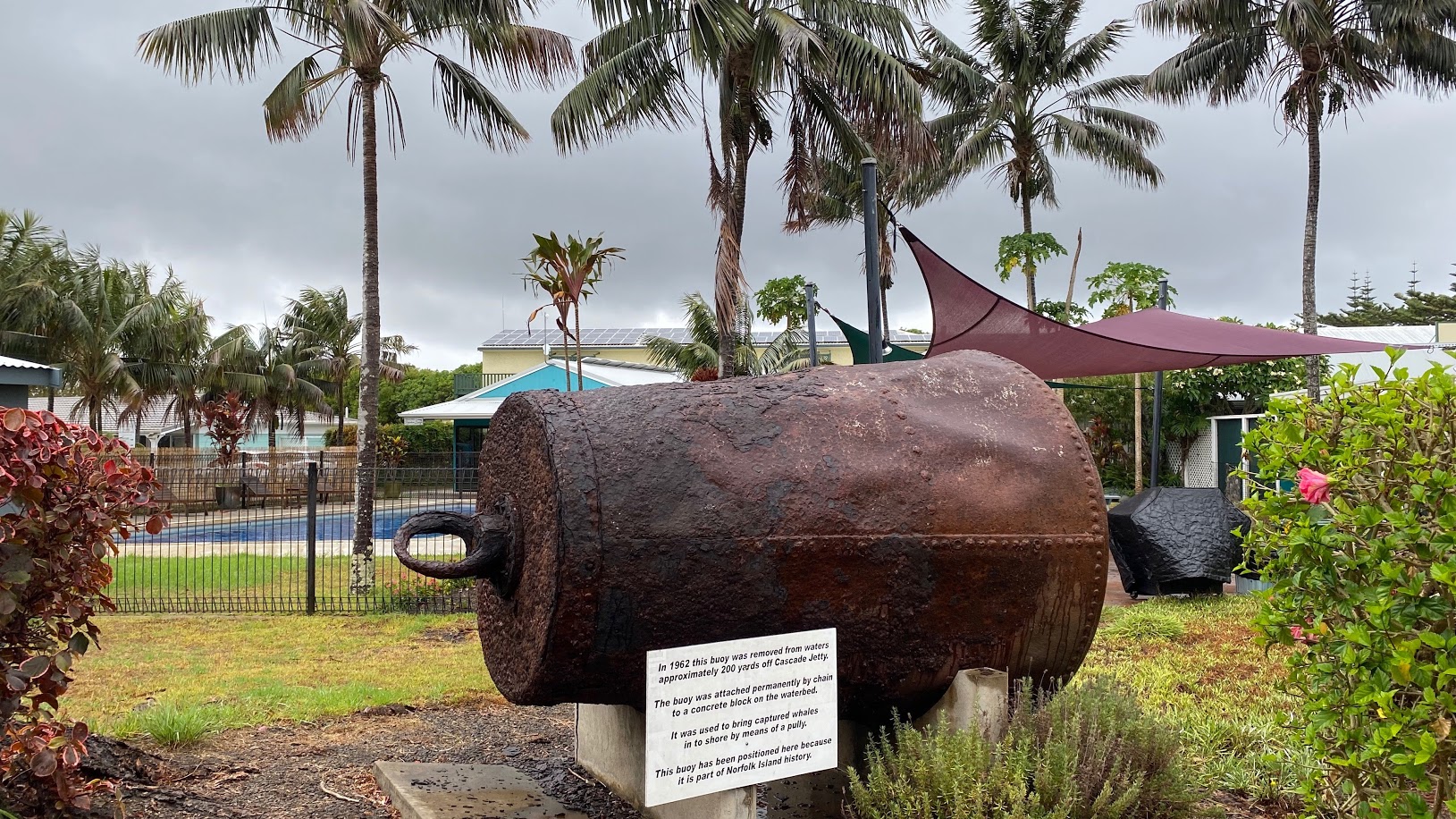
The sign says: “In 1962 this buoy was removed from waters approximately 200 yards off Cascade Jetty. The buoy was attached permanently by chain to a concrete block on the seabed. It was used to bring captured whales into shore by means of a pully. This buoy has been positioned here because it is part of Norfolk Island history”.
And as everyone was hungry again, having not eaten for at least an hour, it was off to the Captain Cook Monument for a barbecue lunch.
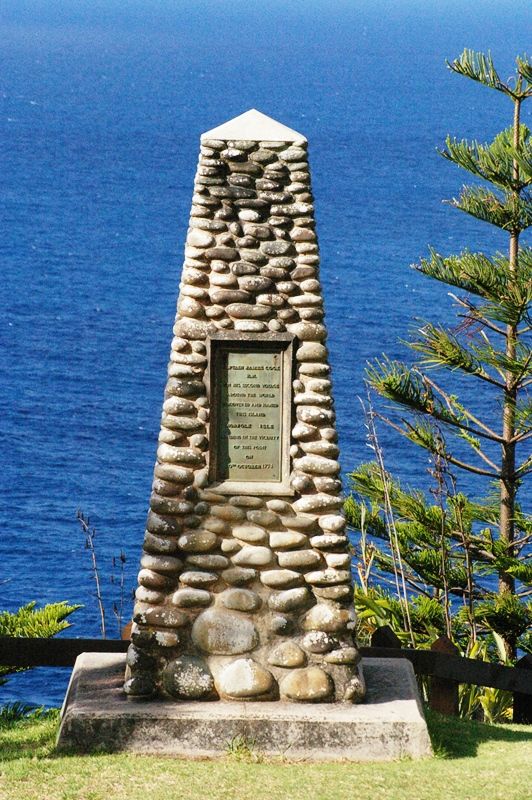
The monument, which is in the Norfolk Island National Park, is on the northern coast where Cook and his officers landed in 1774 on his second voyage around the world in HMS Resolution, is perched on a hill which overlooks the coastline and the endless sea and is decked out with picnic tables, barbecues and toilet facilities making it a popular spot for tourists.
Cook named the island Norfolk Island, which at the time was uninhabited, after the Duchess of Norfolk, the wife of Edward Howard, the 9th Duke of Norfolk. Unbeknown to Cook, the Duchess had already died, but he didn’t know that at the time. Although the island was uninhabited in 1774, and remained so for the next 14 years, evidence has since been found that the island had been previously occupied by Polynesians.
On January 1788 Lieutenant Philip Gidley King was ordered to lead a party of fifteen convicts, 9 males, 6 females and 7 free men, to take control of Norfolk Island so the Island didn’t fall into the hands of the French who were also interested in the south pacific. Lieutenant King is reported in saying that the Island Pines were the most beautiful and finest in the world and would be suitable for masts, yards and spars. Grains and seeds also grow in abundance on Norfolk Island. The only downside to the Island was the lack of a natural safe harbour. Without a harbour this island was of no use, but with a port, Norfolk Island would become of great importance for Great Britain.
The occupation began to flourish. Norfolk Island was soon seen as a farm and its main purpose became the provision of food for Sydney. A township was established and the convicts cultivated the ground and planted crops of vegetables and seeds which were to be shipped back to Sydney to help with the near starvations which were crippling the city. In 1790, Norfolk Island received 300 new convicts and officers from Sydney aboard the HMS Sirius. This new influx of convicts helped relieve the pressure on the Sydney crises. It turned to disaster when the HMS Sirius was wrecked on the reef at Kingston and although there was no loss of life, the stores were ruined and the incident highlighted the settlements vulnerability. The ship crew was marooned on Norfolk for 10 months.
The farming of vegetables and grains for Sydney often failed due to the salty winds as well as the rats, caterpillars and the Norfolk Parrots. The lack of a safe harbour hindered communications and the transport of supplies and produce. Even with these problems a second fleet arrived on Norfolk Island with a cargo of sick and abused convicts, which gave the Island more problems to contend with. In 1794 Lieutenant Philip Gidley King suggested that the penal settlement was too remote and difficult for shipping, and too costly to maintain and should be closed. King left Norfolk Island in 1789 and a succession of short term commandants ruled the island for the next 11 years.
In 1803 the secretary of state, Lord Hobart, called for the removal of the Norfolk Island settlement, to be transferred to Van Diemens Land due to its great expense and the difficulties of communication between Norfolk Island and Sydney. This was a slow process as most of the settlers didn’t want to be uprooted. A lot of the convicts had decided to stay on the Island as settlers after they had finished their sentence. The first group of 159 left Norfolk in February 1805. The group comprised of mainly convicts and their families but only 4 settlers. By September 1808 only around 200 remained on the Island. The structures of the settlement were razed or pulled down stone by stone in order to dissuade passing ships from reoccupying Norfolk Island and also to make the Island less alluring for escaped convicts. The farms were destroyed and the domestic animals were shot.
The Island was finally abandoned by 6th June 1825 and stayed that way for 11 years.
In 1936 it was decided that a final place of punishment was needed for recidivists and other antisocial British subjects, such as Irish political prisoners. These were the dark days of the Island, both in terms of human cruelty and degradation. This period also marked the beginning of the decimation of the island's natural biota, as clearing for large-scale agriculture and ambitious building works began. This cruel era ended in 1855 with the removal of the last of the convicts, as deportation become less popular and other programs for the utilisation of convict labour became favoured.
In 1856, 194 people, including descendants from the Bounty, arrived on Norfolk Island from Pitcairn Island aboard the Morayshire. This group consisted of 40 men, 47 women, 54 boys, and 53 girls. The journey of 3,700 miles took five weeks. Norfolk Island still celebrates the 8th of June as its Anniversary day, it is called Bounty Day, and it is a public holiday.
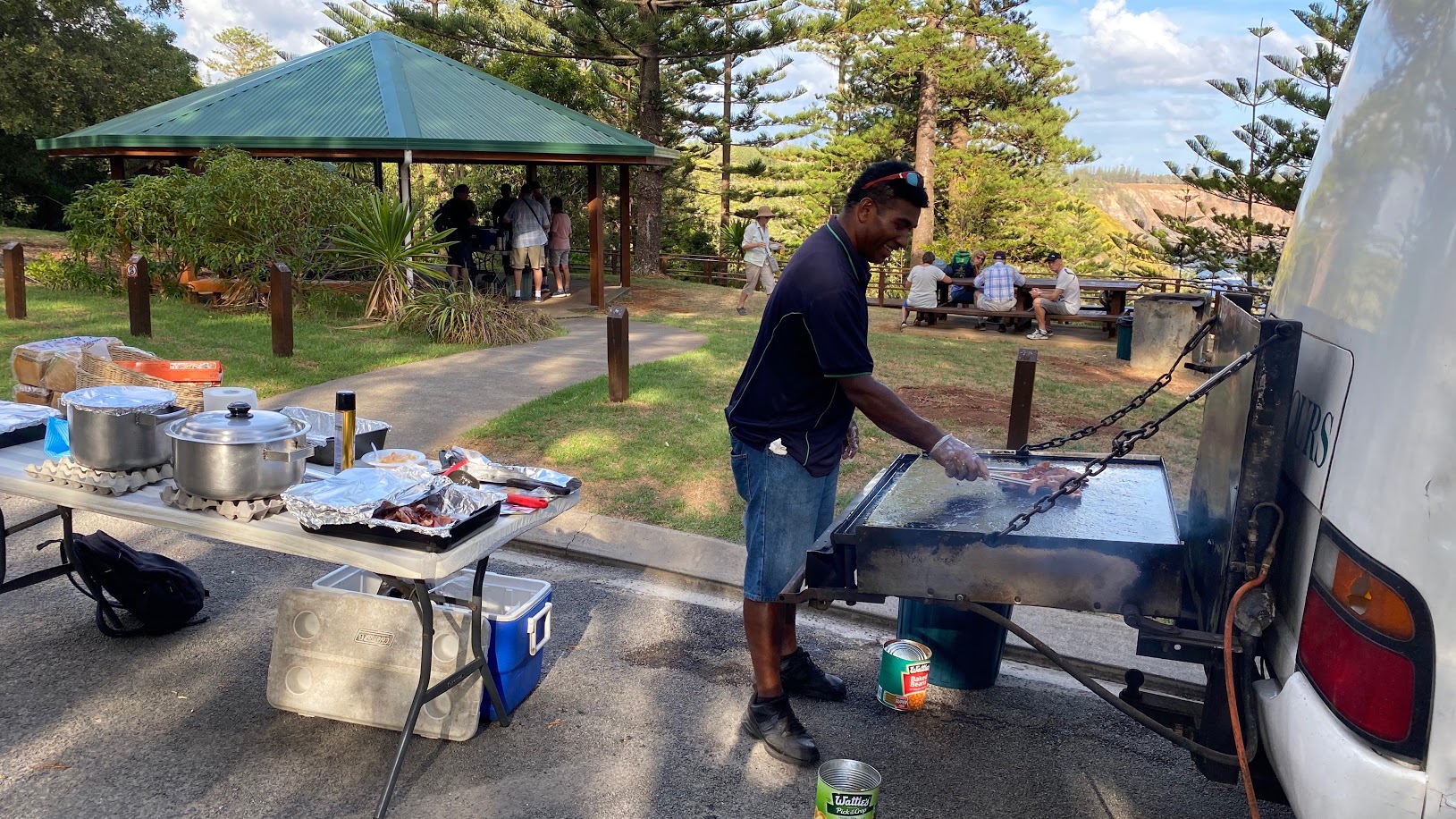
Preparing the barbecue at the Cook Memorial.
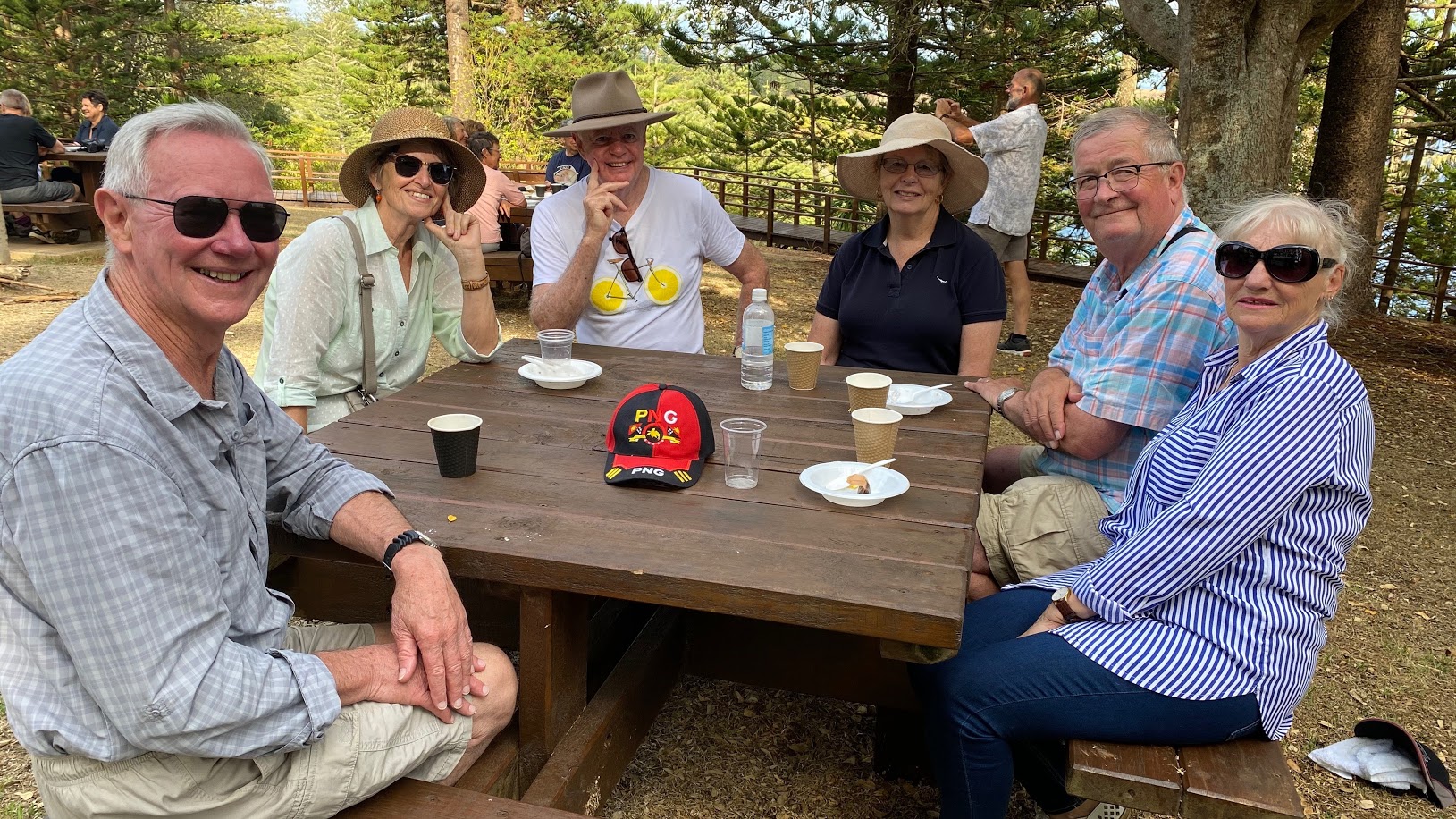
Dick Allanson, Sandra Robey, Paul Robey, Majella Wilson, Col Giles, Anita Giles.
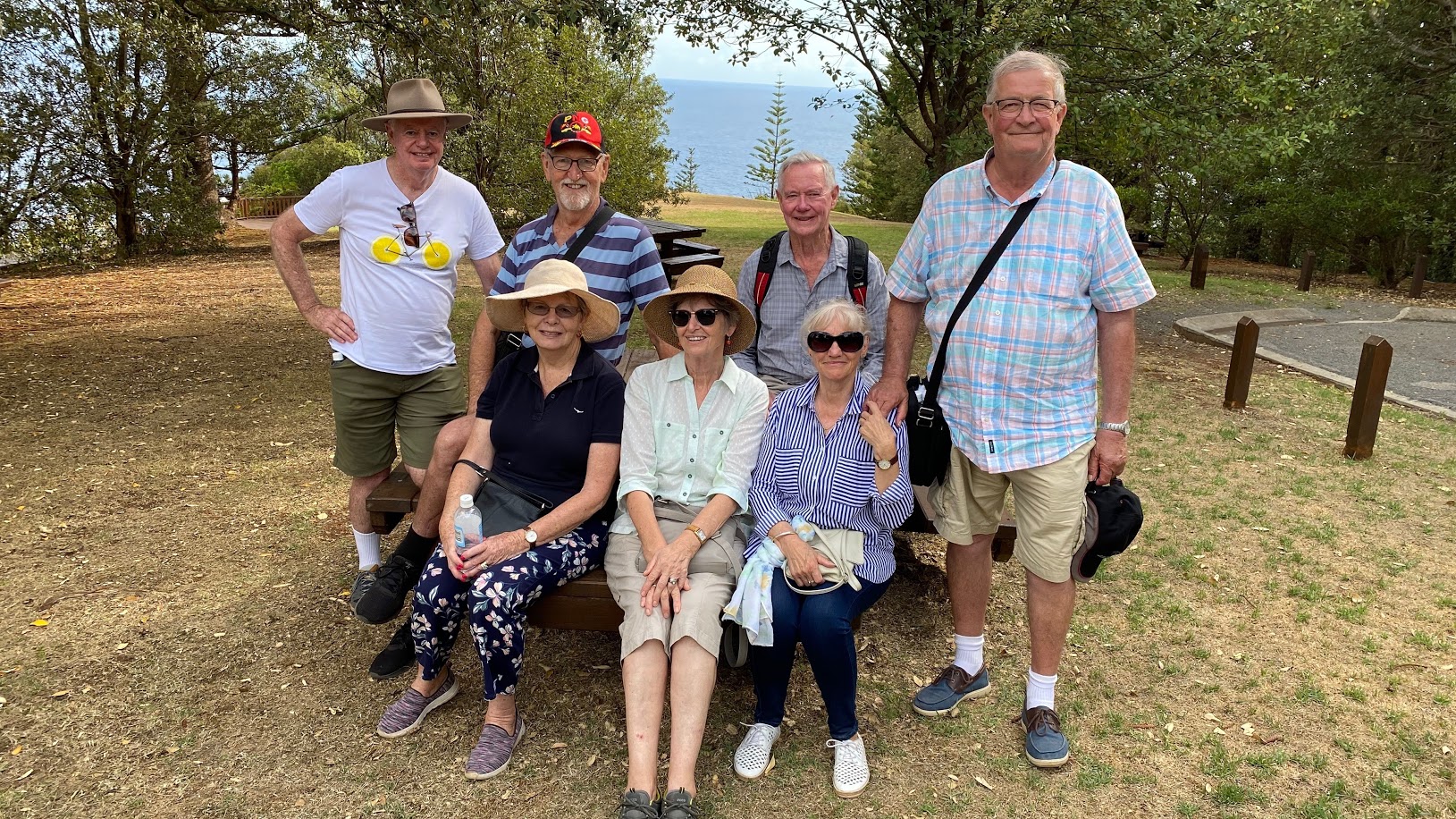
At the Captain Cook monument picnic area,
Standing: Paul Robey, Floyd Wilson, Dick Allanson, Col Giles
Seated: Majella Wilson, Sandra Robey, Anita Giles
I thought growing old would take longer.
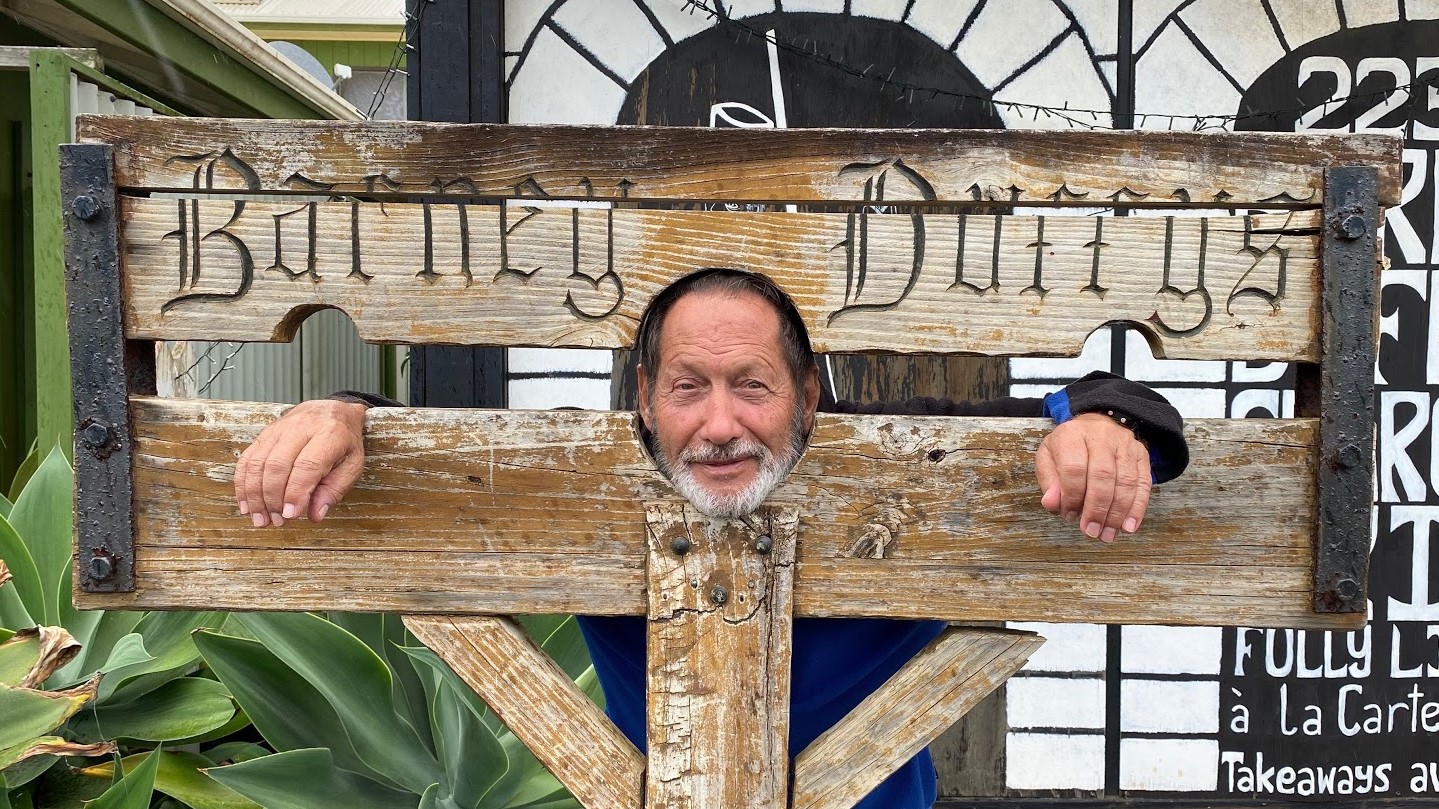
Dave Prowse, in the stocks out the front of Barny Duffy’s Charcoal Grill, many say a place he should have been 55 years ago.
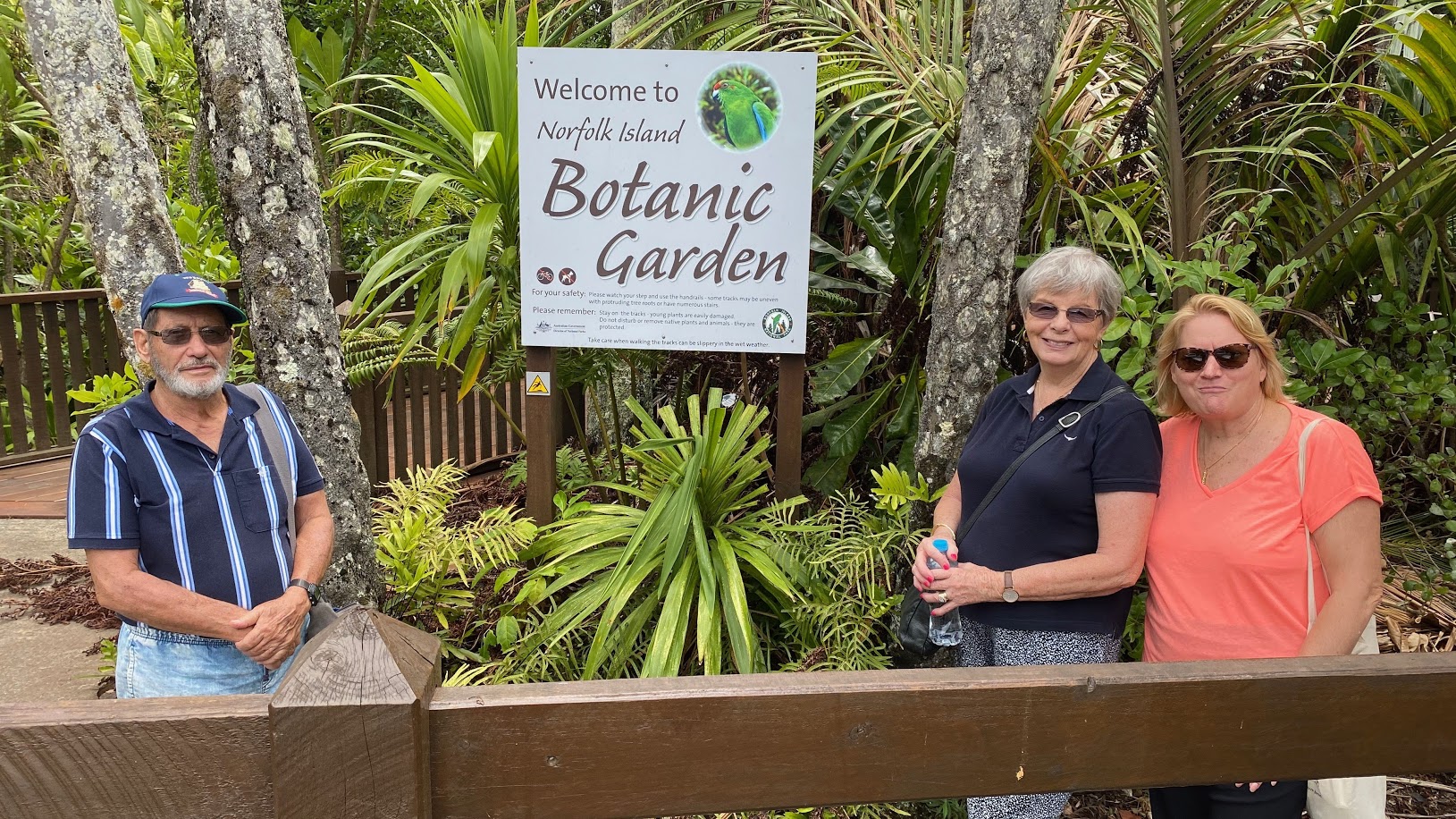
Dave Prowse, Majella Wilson, Wendy Prowse, after walking through the Botanic Gardens. Getting a bit of couth.
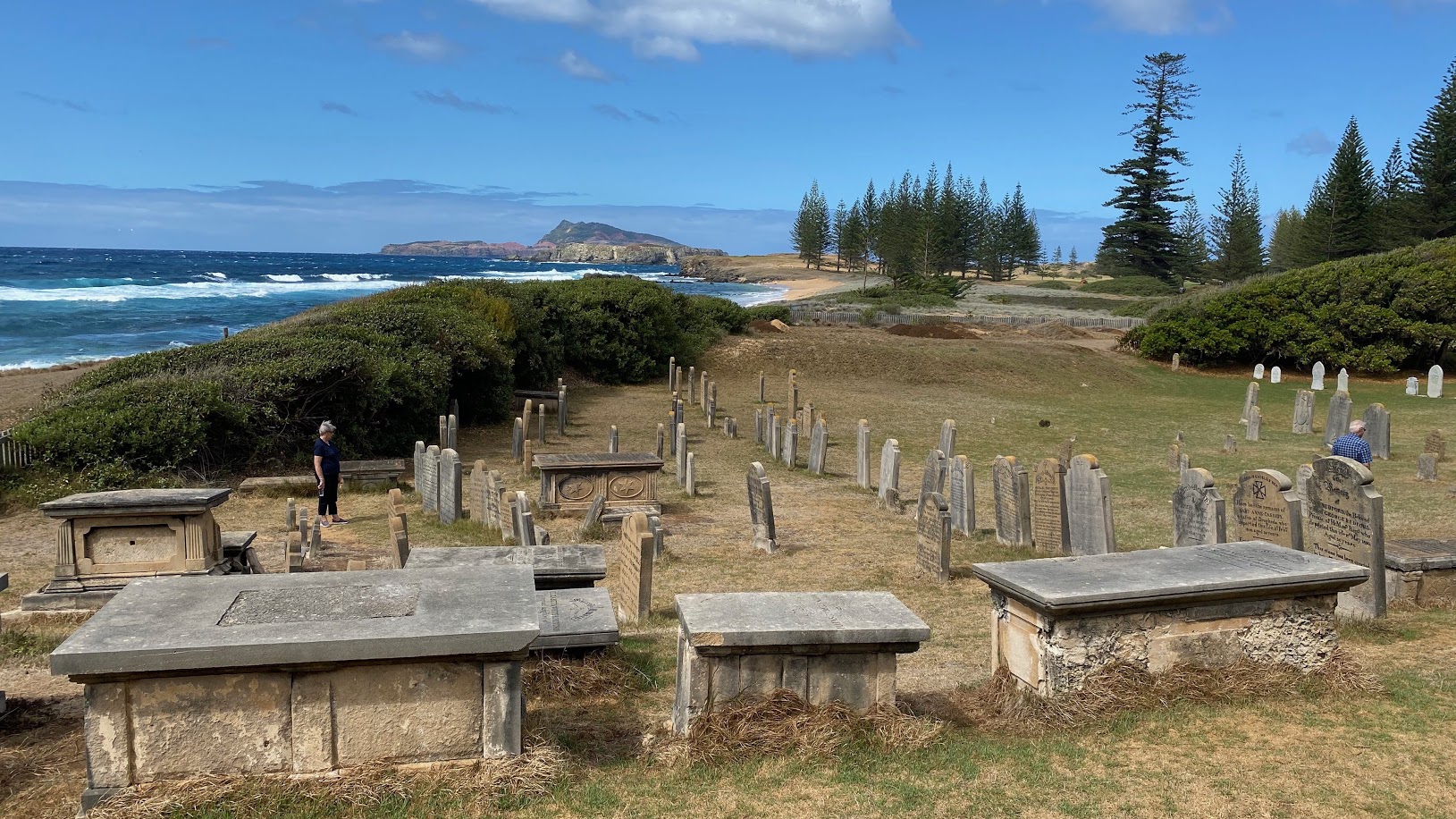
The Island’s cemetery at Kingston.
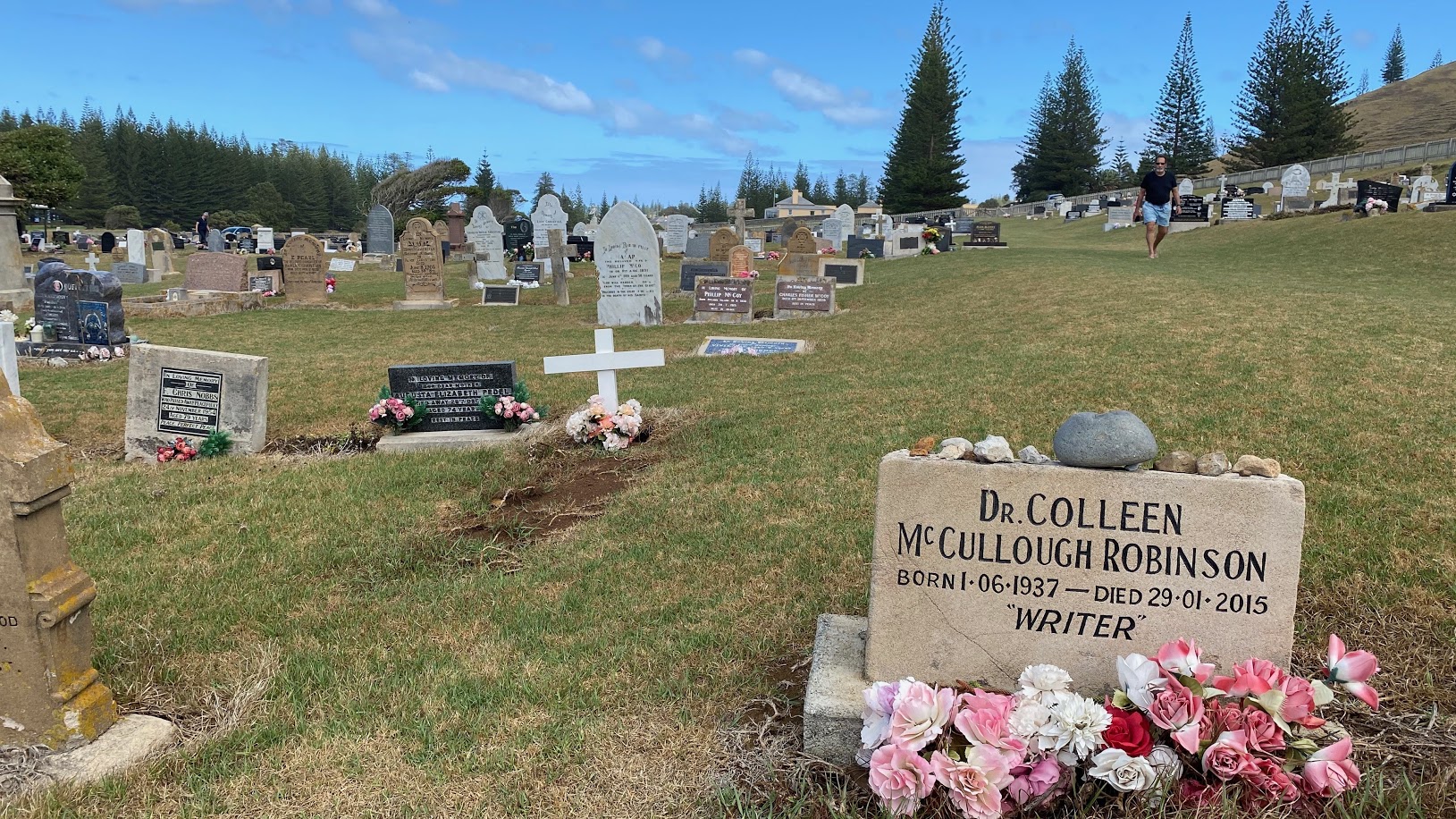
The present Norfolk Island Cemetery, which is situated on the shores of the aptly named Cemetery Bay, is believed to have been established during the Island's second settlement in the 1820s. Before then, burials occurred in various places on the island and the cemeteries used during the first settlement are no longer evident. Nevertheless, headstones and their inscriptions dating from 1792 are to be found here, the early ones probably removed from their original locations and remounted on the current cemetery site. Other headstones from the original cemeteries are believed to have been re-used.
The causes of death recorded on many of the stones reflect the harsh life of the colonial days, including many drownings, accidents and even executions. Amongst them are the graves of many of the descendants of the Bounty mutineers who moved from Pitcairn Islands to Norfolk Island in 1856. Considerable restoration of many of the older stones has obviously taken place in recent years.
Current funeral services are carried out by the Norfolk Island Hospital as there are no commercial funeral parlours or any crematorium facilities.
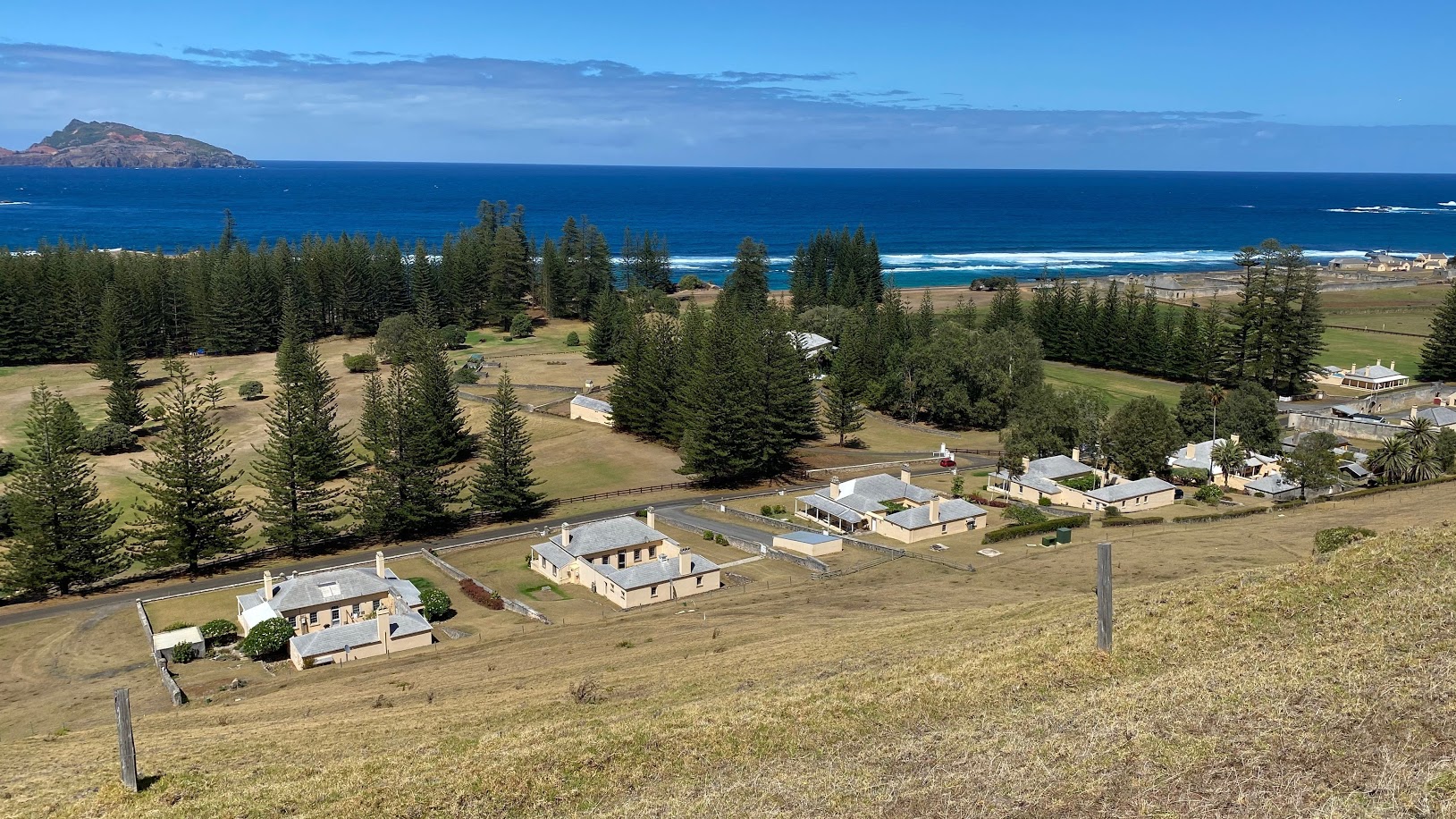
The Officer quarters, part of the remains of the old convict settlement at Kingston.
My wife says I only have two faults,
I don’t listen and something else.
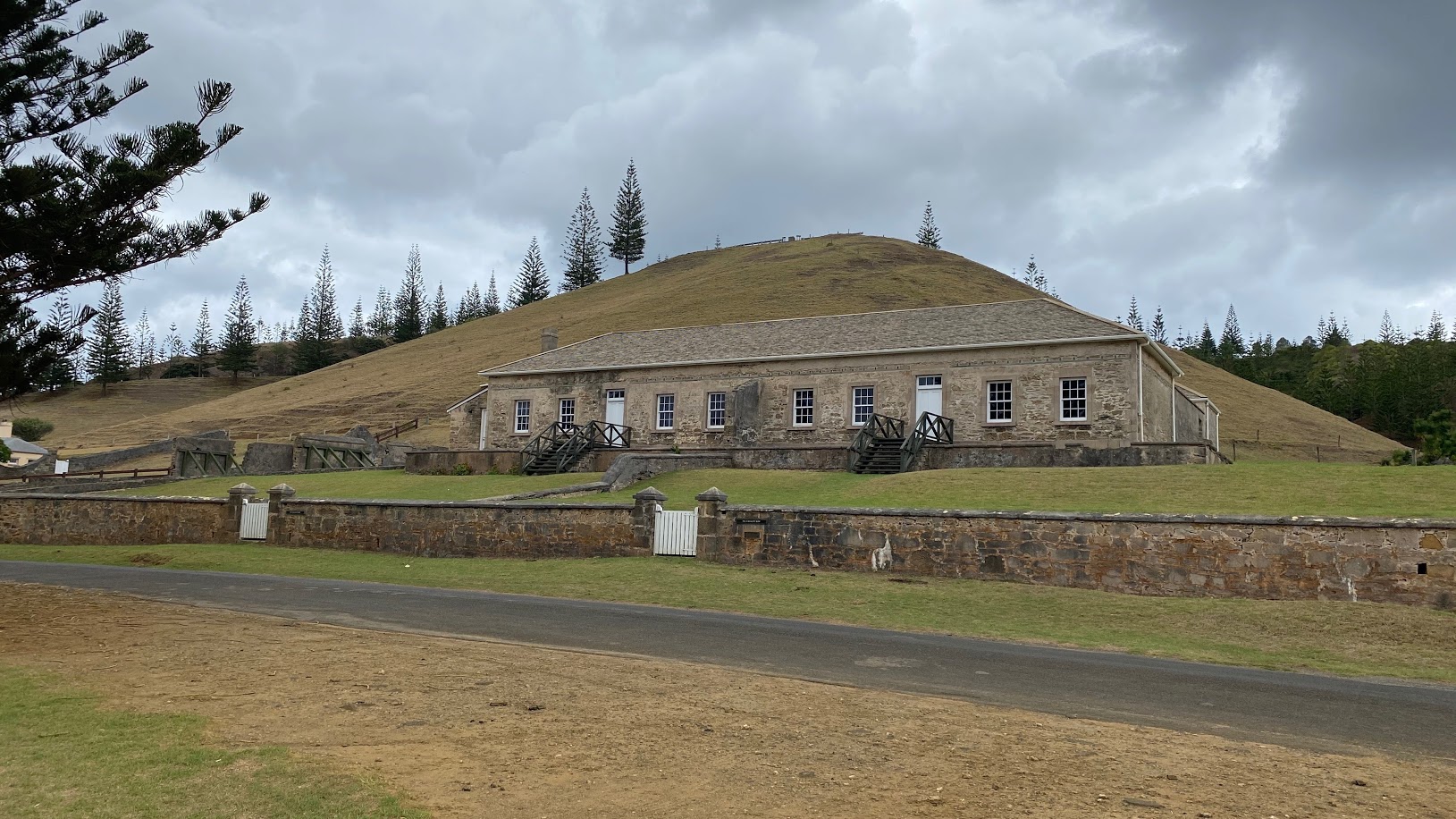
Officers quarters. If you had to be anyone on the Island back then, it made sense to be an Officer. Not a lot has changed really!
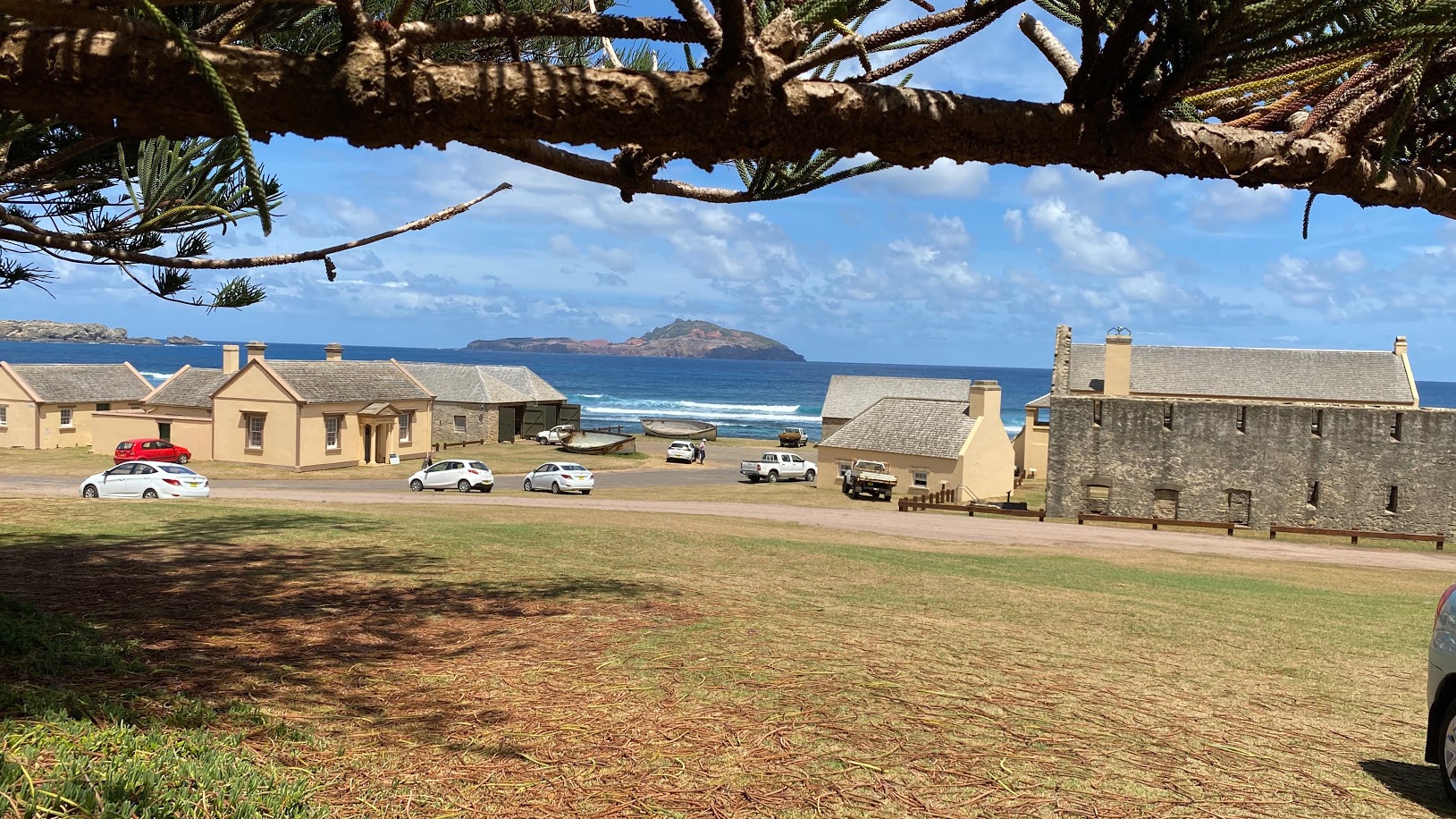
On the right is the surgeon’s quarters and the hospital. In front of them is the guard house and crank mill. On the left is the Royal Engineer’s office and the blacksmith’s shop.
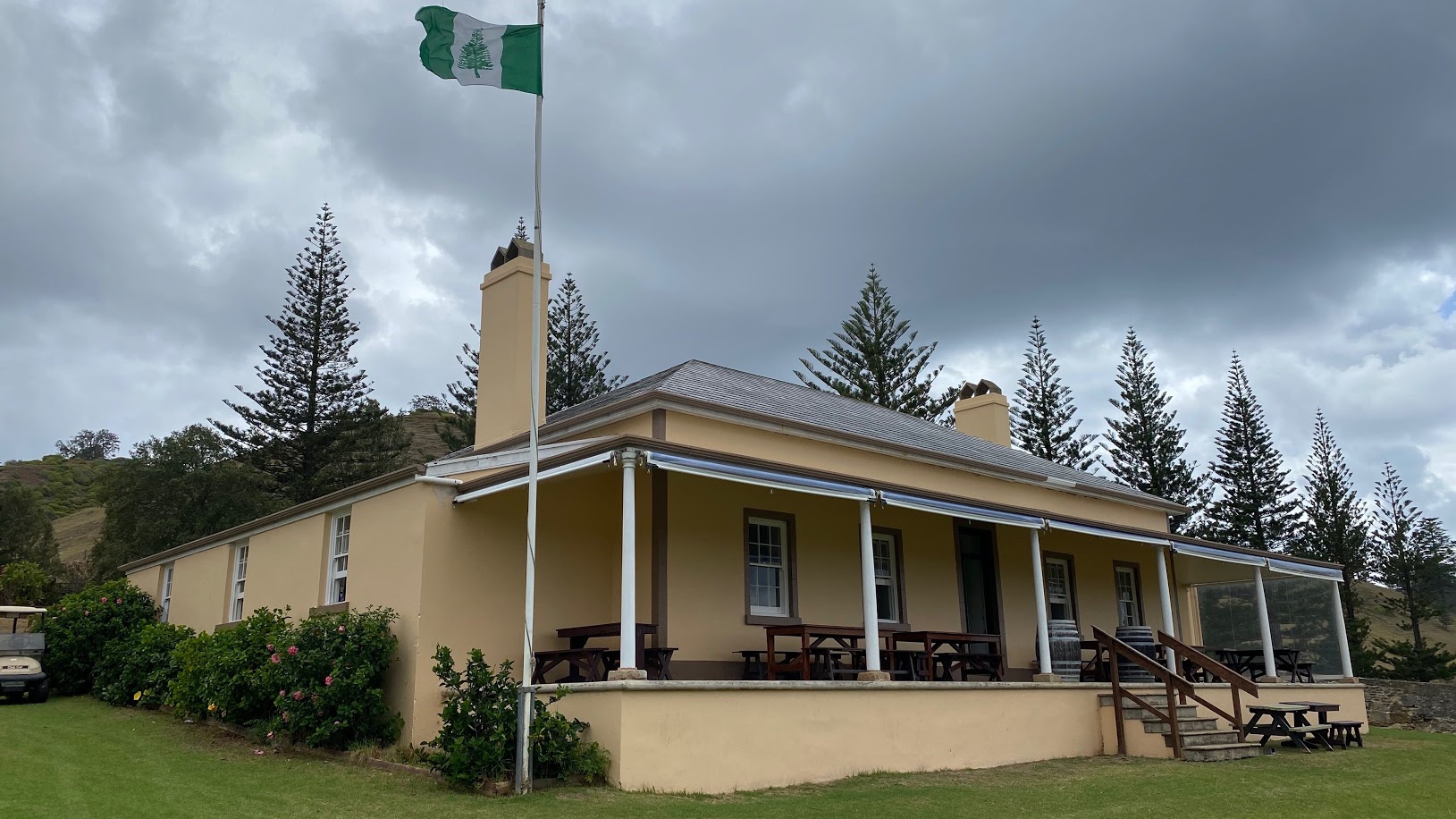
The old Magistrates Quarters, now the golf clubhouse.
The row of Officers’ Quarters were built on Military Rd between 1932 and 1847. The similar symmetrical Georgian houses have a separate kitchen and servants’ quarters at the rear, linked by an enclosed service courtyard. They were built of calcarenite, a locally quarried limestone and had timber shingled roofs.
The building above was the last built, commencing in 1845. It was constructed for the notorious Stipendiary Magistrate, Samuel Barrow. He was brought to Norfolk Island to enforce prisoner discipline and his actions in 1846 precipitated a convict uprising with 12 of the perpetrators executed. Military Road was renamed Quality Row by the late 1880s.
The Quintal family was allocated the house in 1856 and in 1903, descendants of the family were still living there when the NSW Government introduced a licence system which meant the occupiers could remain in the houses, free of charge, provided they maintained them. What seems to be a fairly good deal upset a few of the tenants who rejected it outright and were therefore compelled to vacate. This upset them even more and they burnt down three of the houses, one of which was the old Magistrates Quarters.
In 1842, Golf had been introduced to the Island by the convicts and in 1907 the golf club began to use the old burnt out building, a wooden structure was added to the front of the building and a tank was installed in its centre. The course today is technically Australia’s oldest, existing on its original site. By 1949 the old building was an eyesore and was recommended for demolition but the golfers got together and cleaned it up a bit. Common sense then prevailed and it was decided to rebuild the building back to its original condition and it was opened by the Queen in 1974 and remains the golf clubhouse today.
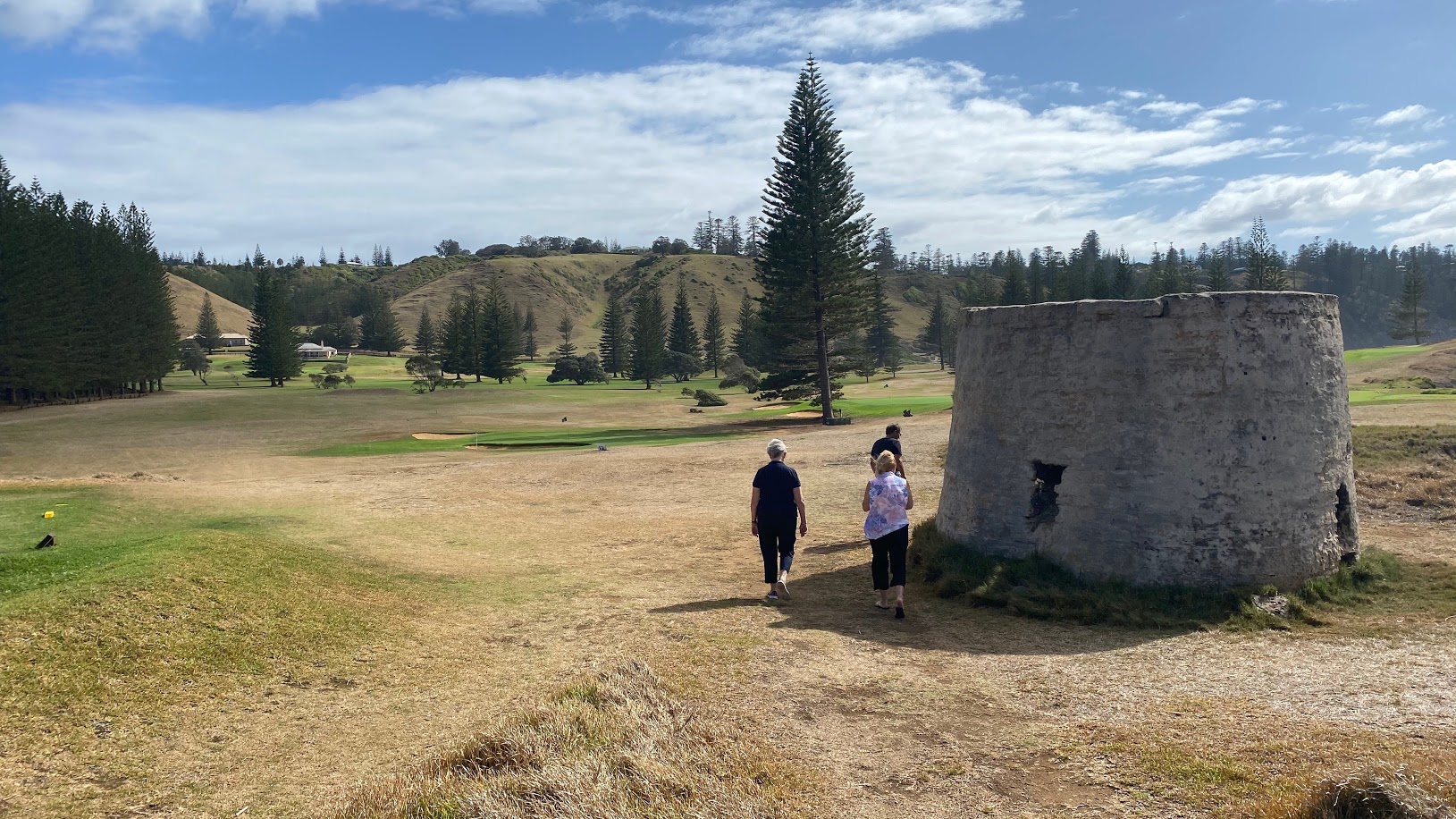
An old lime kiln on the golf course.
Lime, or ‘quick lime’, is the product obtained by burning limestone and other calcium-rich substances such as shell and coral. Limestone is comprised of calcium carbonate (CaCO3) which breaks down during the process of burning to calcium oxide (CaO), or lime and carbon dioxide (C02) which is driven off leaving behind the lime in a lumpy or powdery form which may be white, or coloured by Impurities. In the process of burning the limestone undergoes a loss of approximately 44 per cent in weight and 12 to 20 per cent in volume and this shrinking of the load is the primary way in which the operators of the simpler methods of lime-burning judged that the process was complete.
The lime Is then slaked with water to form calcium hydroxide or hydrated lime (Ca[0H2), which is mixed with sand to make mortar. As the mortar dries it reverts to calcium oxide (CaO), and absorb8 carbon dioxide from the air to form calcium carbonate (CaCO,), thus completing the cycle.
Varying degrees of Impurities give limes with different characteristics. Lime with a high calcium content slakes quickly giving off considerable heat and makes rapidly setting mortar. Hydraulic limes, which have 10 to 30 per cent of clayey impurities, produce hydraulic cement which is able to set in water as well as in air. ‘Natural’ or ‘Roman’ cement, and ‘Portland’ cement are types of hydraulic cement, the later being produced by the re-burning of an artificial mixture of lime and other substances (silica, alumina, and iron oxide). Lime Is used for a variety of purposes, including mortars and plasters in the building Industry, in agriculture to open and lighten clayey soils and improve other soils in various ways and in a variety of chemical and industrial processes.
Lime-burning is a very simple process. The most primitive method was one where limestone or shell was piled on top of or was interlayered with fuel and burnt in the open. A slightly more sophisticated variation was to place the heap in a pit. Such piles might be plastered with mud, clay or turf In some cases. Various forms of kilns were built for the burning of lime. Intermittent Kilns were loaded, fired and emptied for each load of lime. Such operation was expensive in labour and fuel, as the kiln cooled down after each load.
There were various forms of intermittent kilns used, some operated as ‘flare’ kilns where the fuel and the limestone were kept separated, arid ‘mixed feed’ kilns where fuel and stone were loaded in alternating layers. Continuous kilns were so arranged that fresh fuel and stone could be placed in the kiln and burnt lime withdrawn without interrupting the continuous burning process.
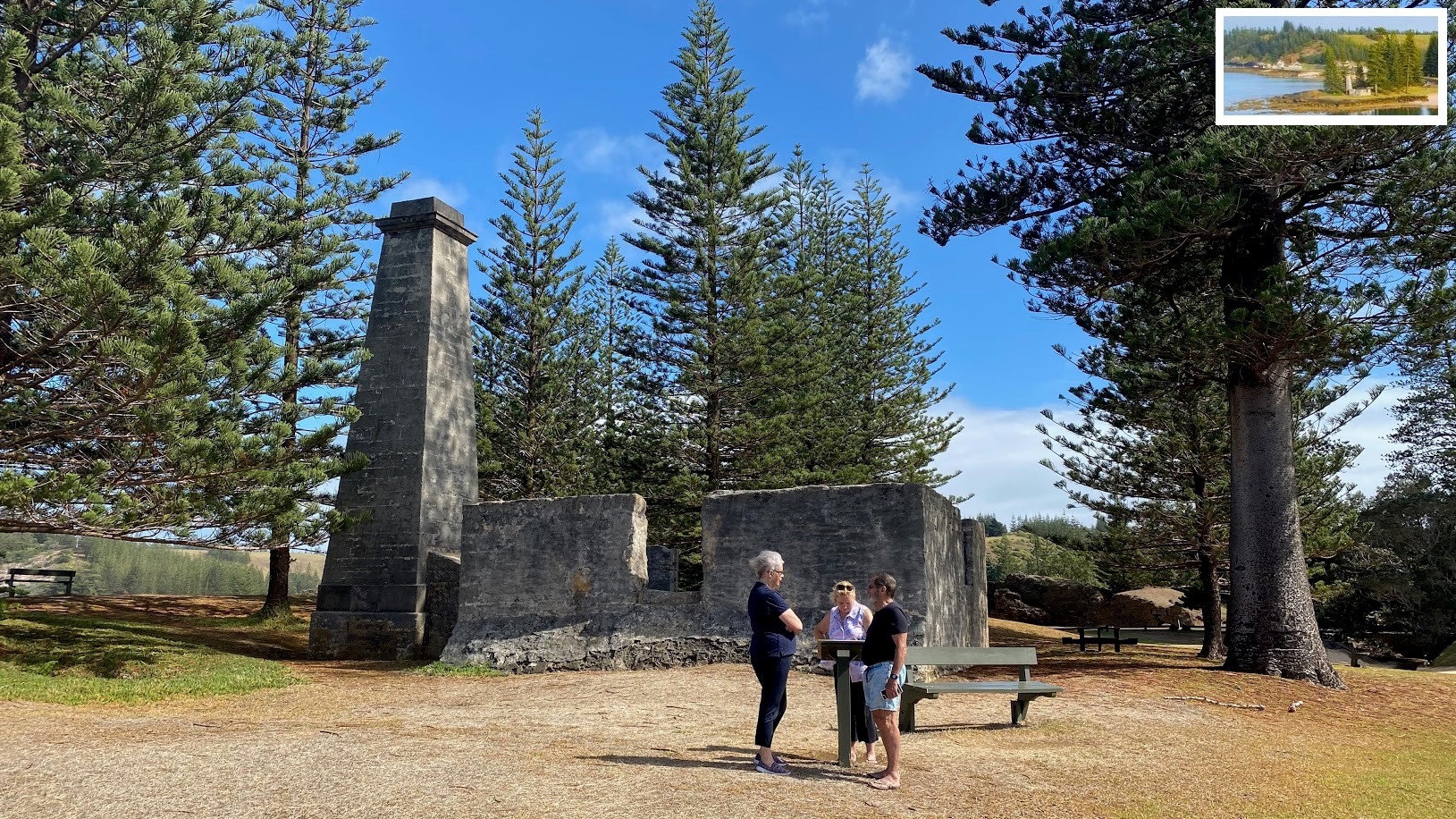
Majella Wilson, Wendy and Dave Prowse at the old Salt House which sits on a point next to the shore - see insert.
The Salt House was built in 1846 and is one of the most intact examples in Australia. Salt was a valuable commodity during the penal settlement. It was used to preserve meat, usually pork. In 1846 the daily ration for convicts was - "1 pound of salt meat, 1½ pounds of maize meal, 1 ounce of sugar and ½ ounce of salt.
Salt was extracted from sea water by evaporation of concentrated brine. In wetter climates such as Norfolk Island, England and Tasmania, this method of salt production was employed as the salt water could not be left to evaporate naturally in the sun. Concentration tanks were cut into the reef adjacent to the Salt House. A gate trapped the water at high tide and allowed the sea water to partially evaporate in the sun. This concentrated solution was them pumped or carried to evaporation pans in the salt house under which fires were lit. After the water had boiled dry, the salt was collected and stored in baskets. The hinged roof had a vent to allow the steam to escape. The construction of the chimney was unusual as it is separate from the building. The low connecting section contains flues which feed the chimney.
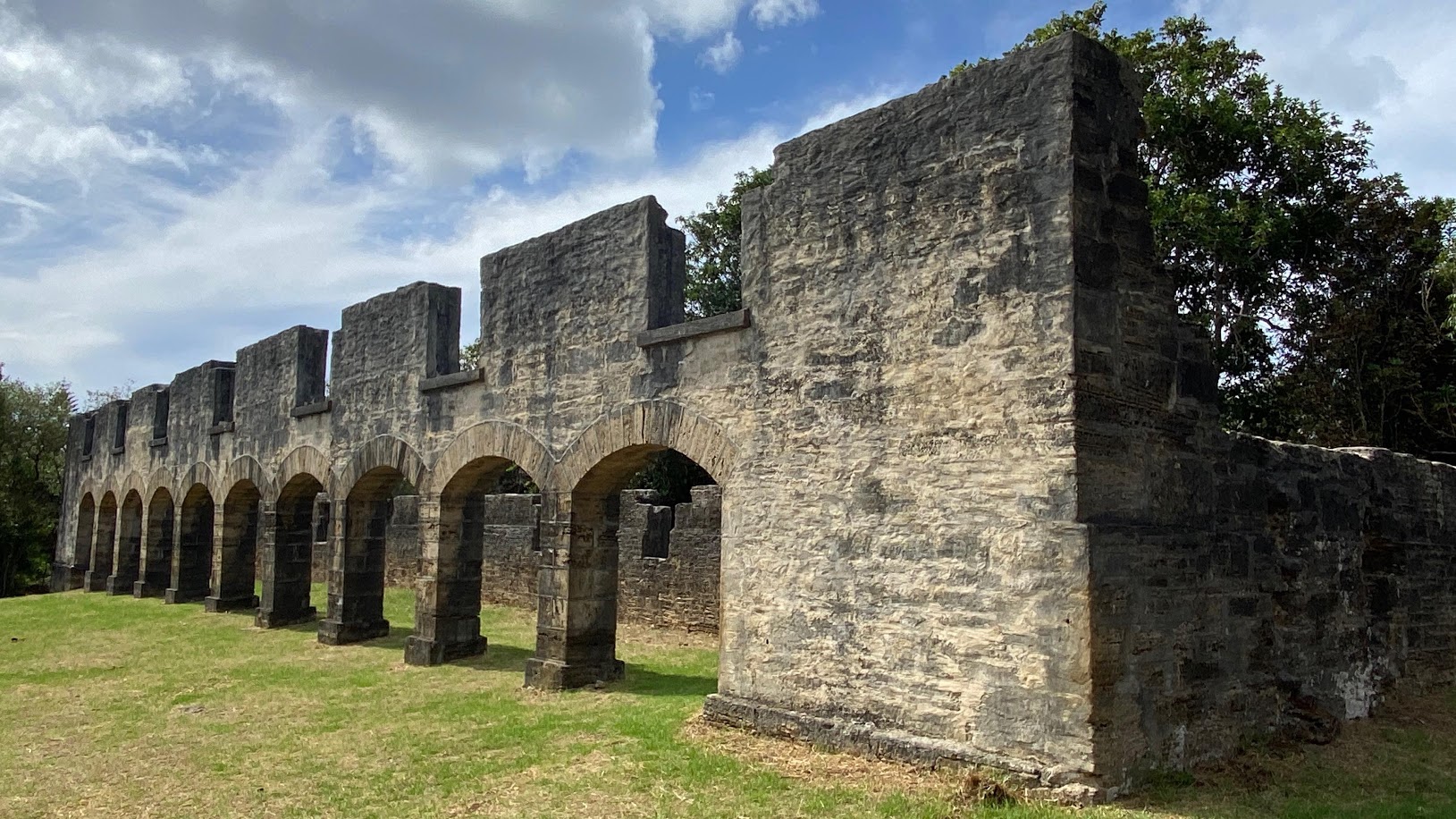
The origin of this building is unclear, it was either convict quarters or horse stables.
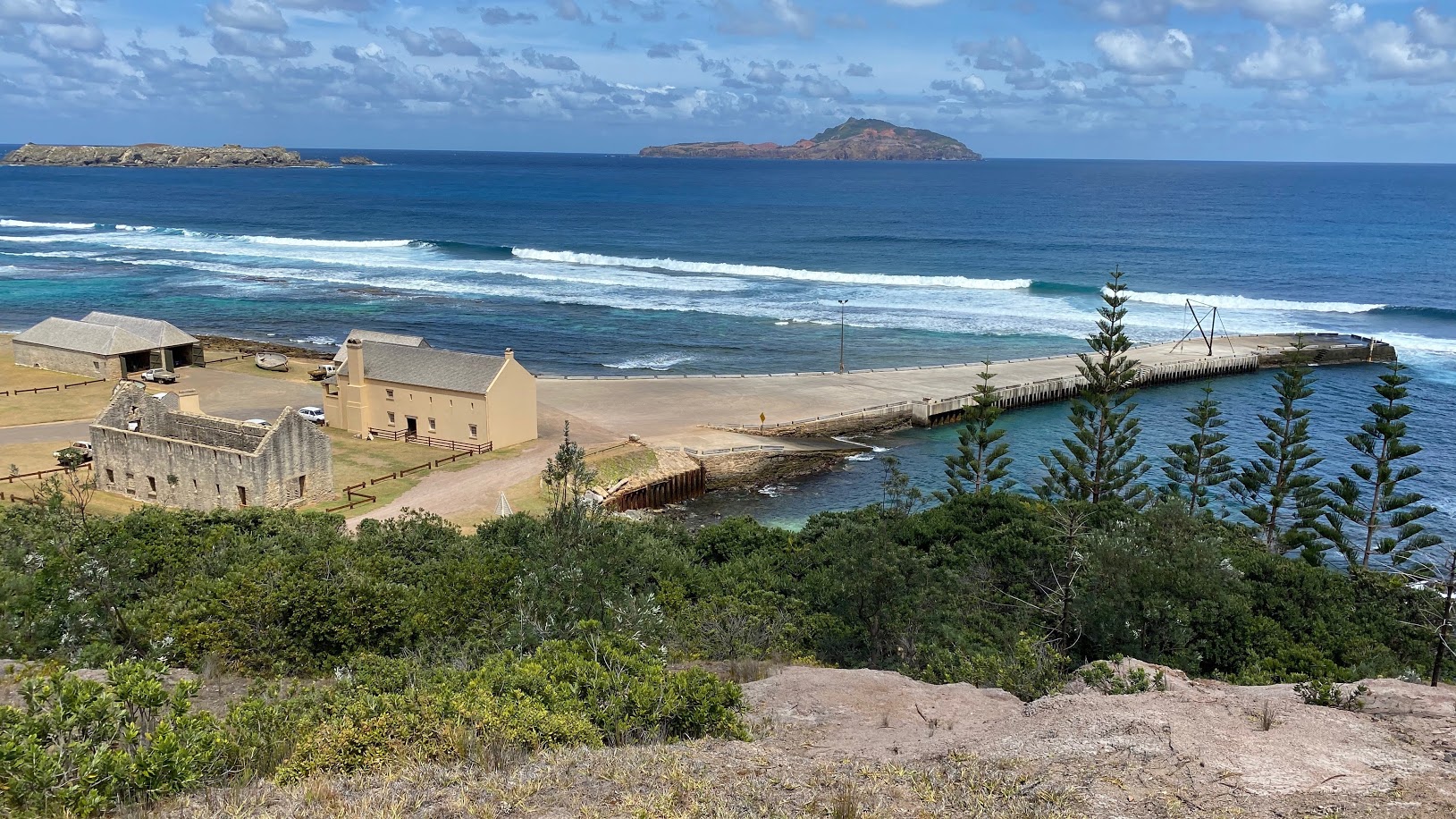
Kingston, on the south side of the island, is the site of the convict settlement. On the left are the hospital and the surgeon’s quarters. On the right is one of the Island's jetties.
All goods are shipped in, the boats anchor off shore, goods are loaded onto barges and towed to the jetty.
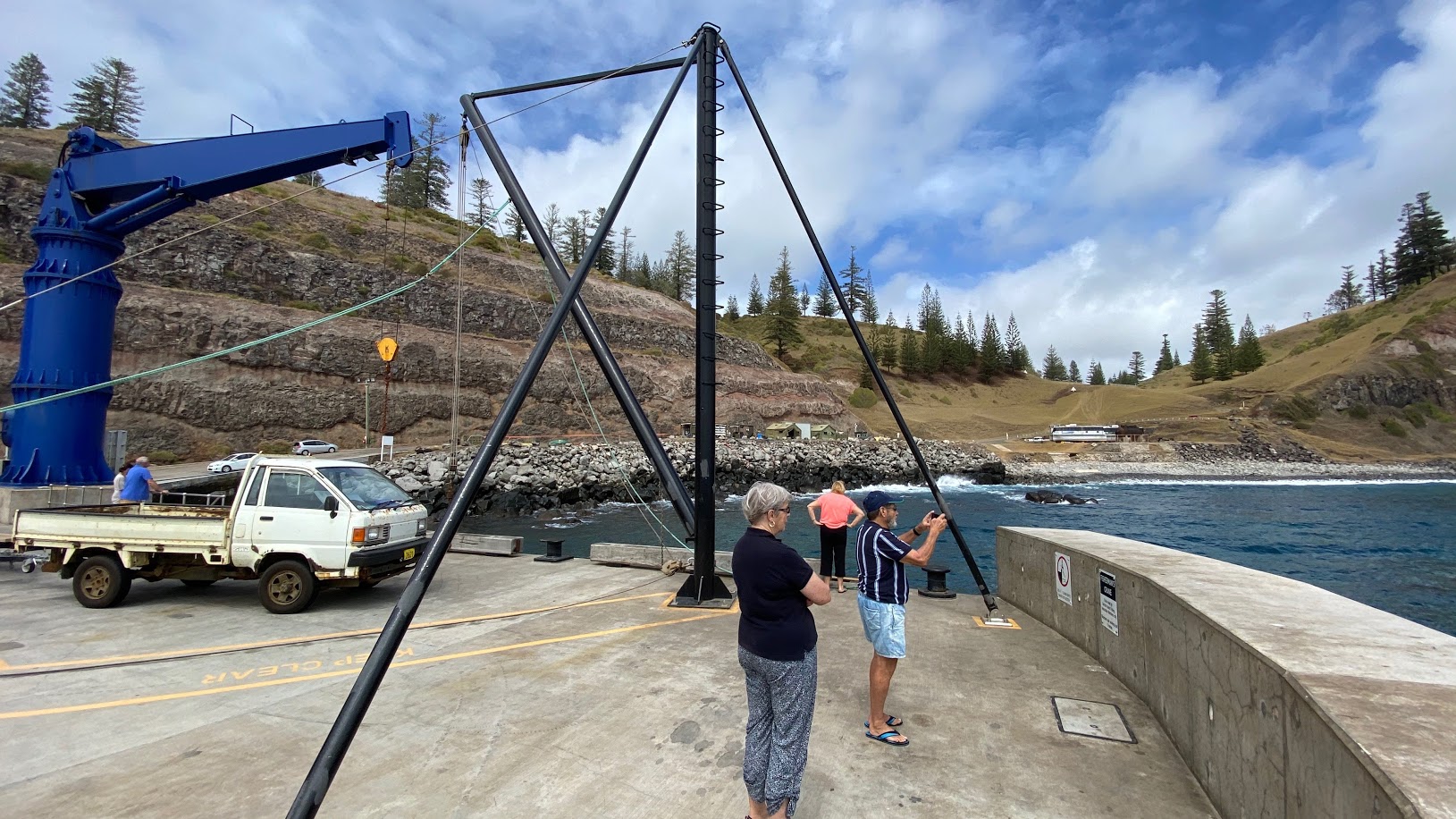
The newer jetty on the north side of the Island, where goods brought onto the Island are off loaded.
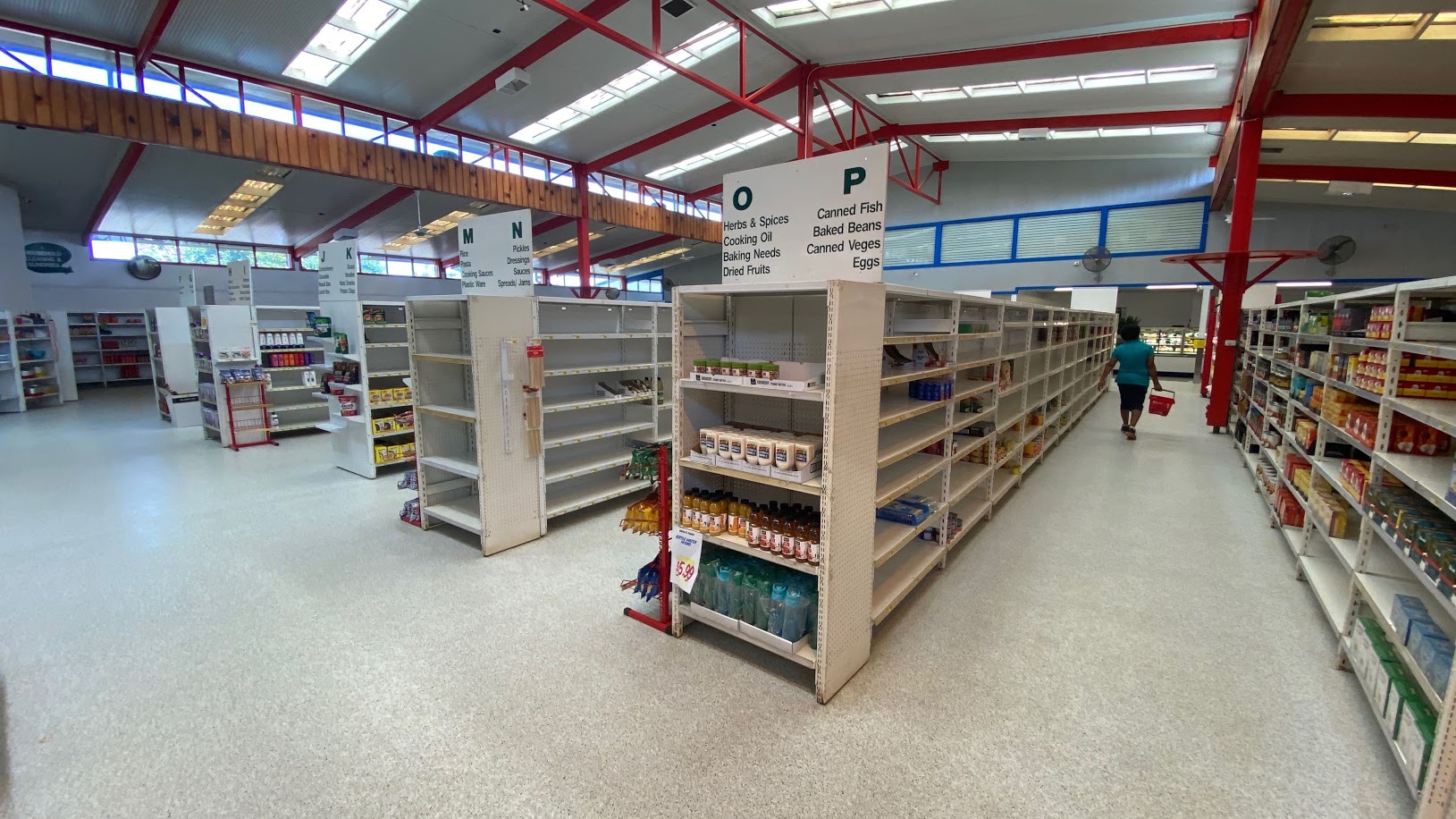
If the ship does not come in, groceries are in short supply. The island was suffering a food shortage because the sea state was too rough to unload when the last supply ship arrived
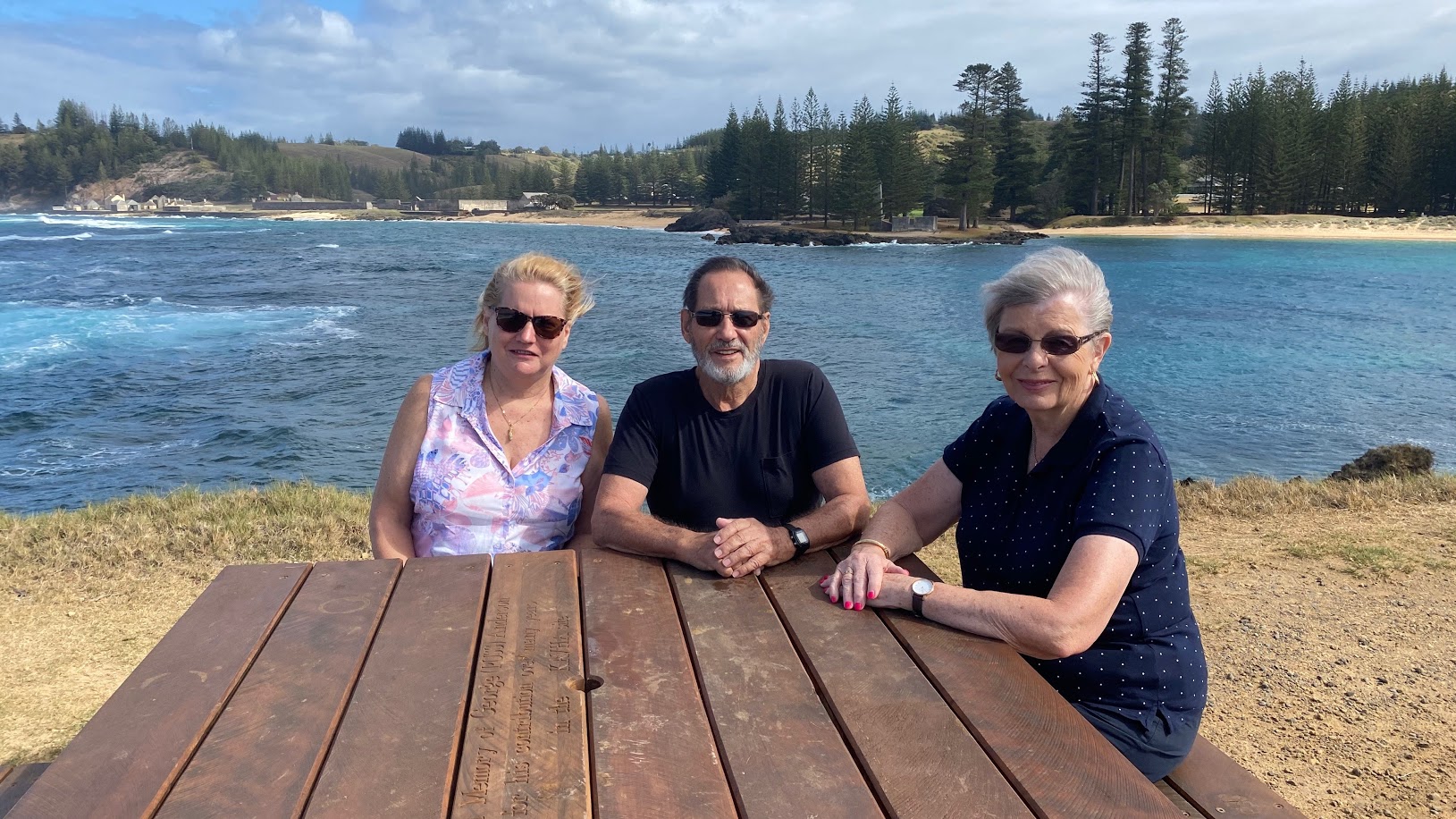
Wendy Prowse, Dave Prowse and Majella Wilson at Emily Bay, not far from Kingston (in the background).
Cows rule!
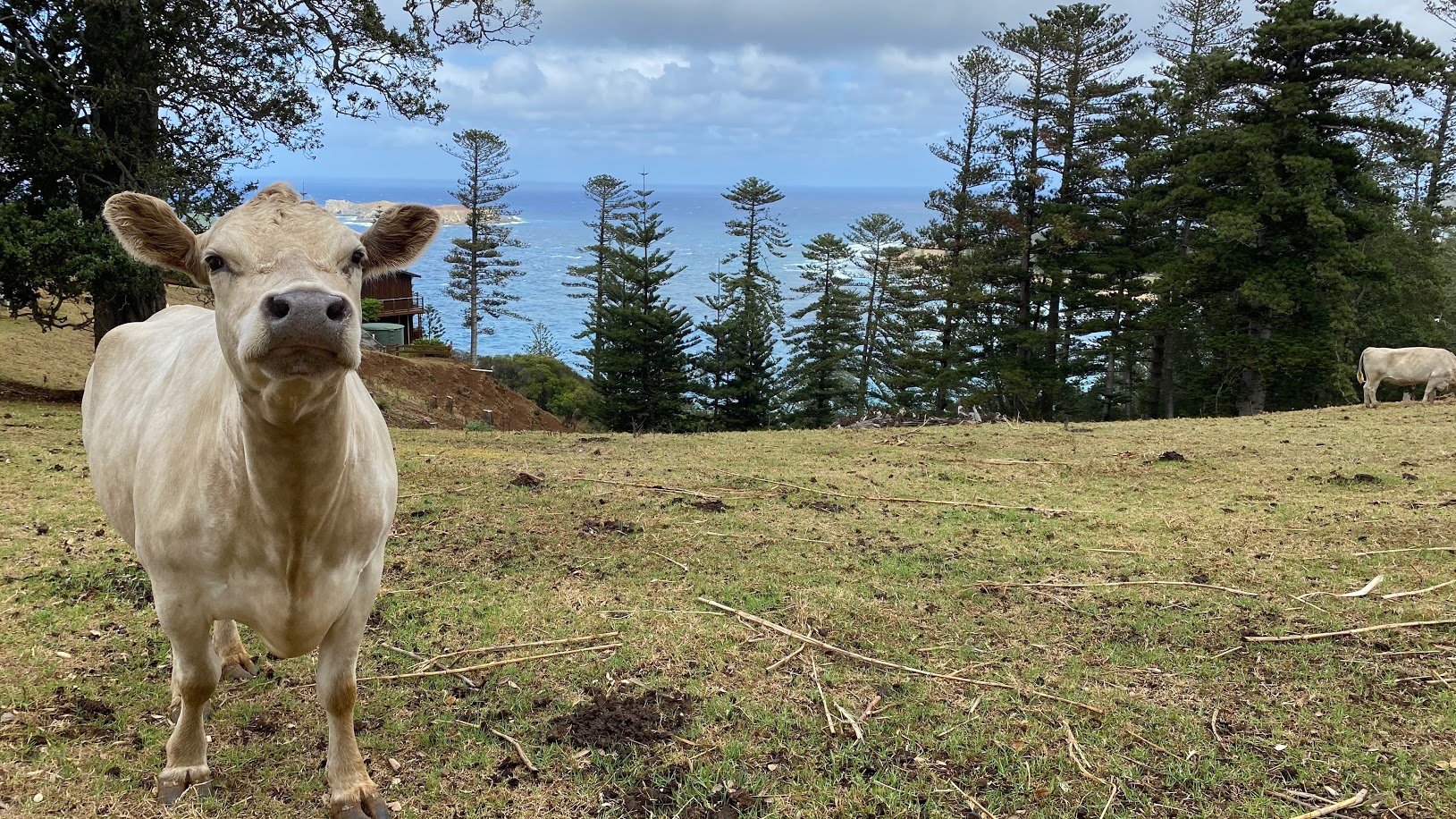
Cows have the right of way on the Island – but even so, it makes good sense not to crash into one, they tend to change the look of your car somewhat.
|
One animal that doesn’t have right of way on the Island is the cat.
Wild cats cause an awful lot of damage to small native animals and any cat found roaming free is quickly sent to its maker.
|
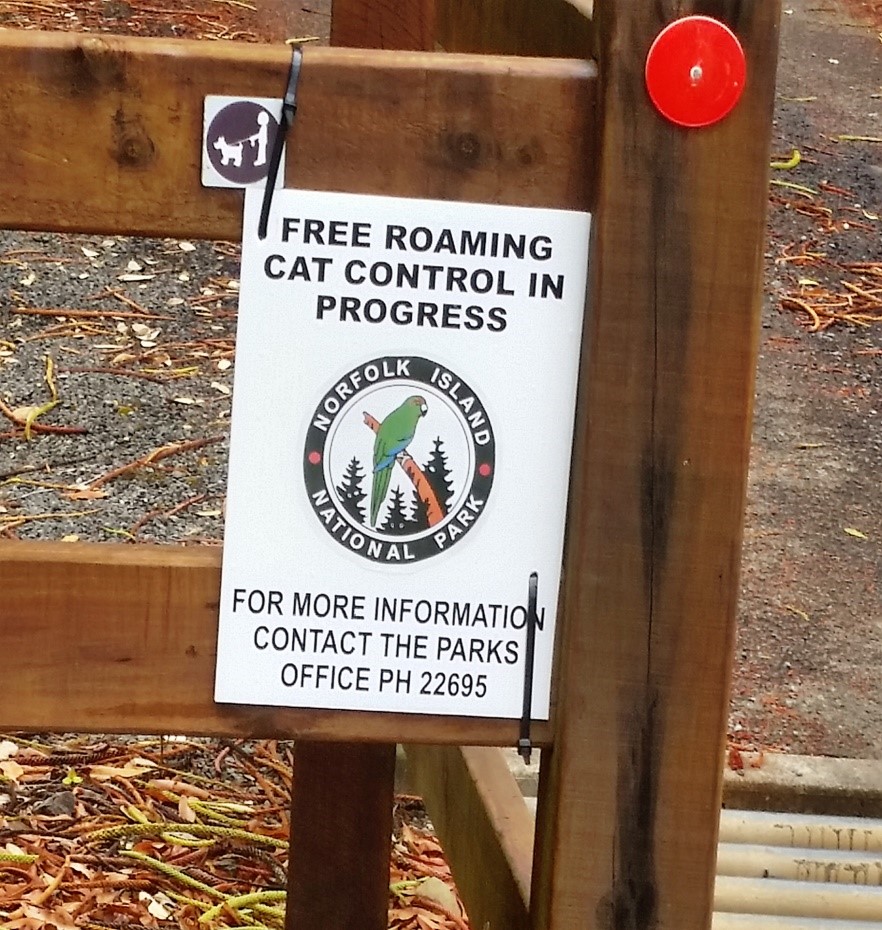 |
|
While on the Island, Laurie ran into, what he thought, could have been a relation of sort, even though it was probably far removed.
He believes that before he came upon the earth as an Appy brat, in another life he roamed free as one of nature’s pets and he spent a quiet hour with these chappies trying to determine whether or not he was related.
Luckily, he still remembered some of their language and they were able to converse backwards and forwards for some time before he finally came to the conclusion that he was from a long line of the Mongolian breed and that they were not related.
Even so, they did promise to meet up later in the day and share a few thistles and a saucer of milk together.
|
|

Then sadly it was time to go home – to board the Air New Zealand Airbus A320 for the 2½ hour flight back to OZ.
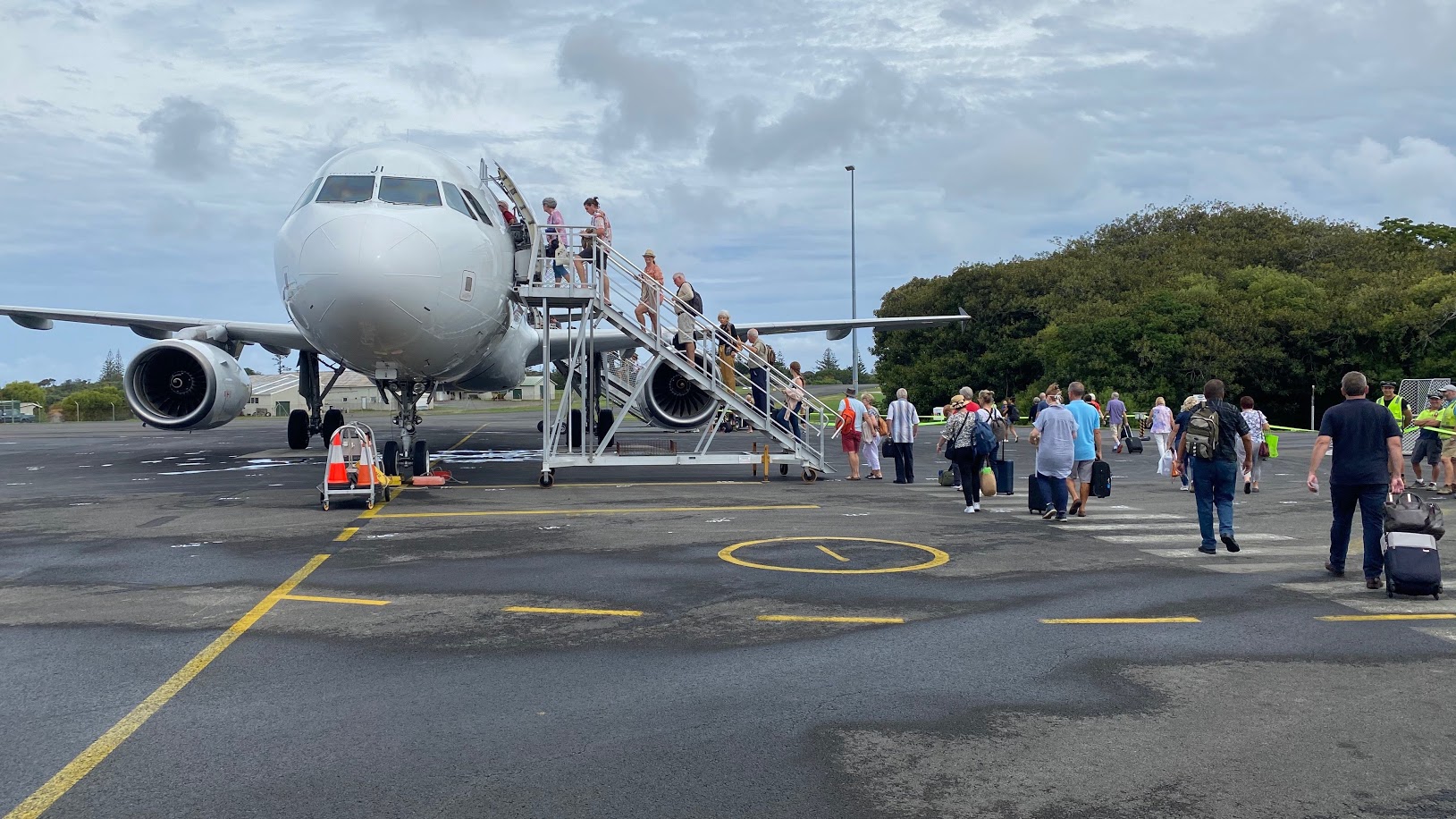
No airbridge at Norfolk Island, it’s grab your bag and out onto the tarmac you go, rain, hail or shine.
A wonderful time was had by all, and a trip to Norfolk is highly recommended.
4 out of 3 people struggle with maths
Back Go to page: 1 2 3 4 5 6 7 8 9 10 11 12 13 14 15 16 17 18 19 20 Forward
